Session F2A DEVELOPMENT OF COACHING COMPETENCIES IN STUDENTS THROUGH A PROJECT-BASED COOPER
Mentorship 2-Art of Coaching 2011
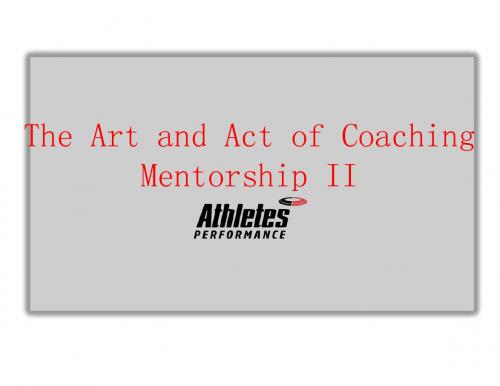
• Over-Coaching: “Paralysis by Analysis”
– Coach: “On your next rep I want you to keep your knees over your toes with your chest-up…hips should be back with your weight on the middle of your feet…keep your core tight and don’t forget to breathe” – Athlete: So what do you want?
The Art of Coaching…
The Act of Coaching…
Coaching: Key Considerations
• Stages of Mastery
• Organization (Eliminate Distractions)
• Session Flow • Technique Instruction (Verbal)
– Repeat example in multiple locations if necessary
• If you are unable to do the movement then a model athlete can be used • Pursue technical mastery of everything you teach as your personal injuries and abilities allow
Coaching Keys: Verbal Instruction
Left Hemisphere
Verbal Processes • Active Mind • Careful • Effortful • Judgmental • Analytical
绩效管理咨询方法论英文版

Tie PM to the Business Cycle
YearEnd Review
New Year Planning
Review and
Planning Planning
Feedback &
Coaching
Feedback & Coaching
MidYear Review
Bad timing
I don’t want to ruin your day Herman, but tomorrow morning you’re scheduled to be in my office for your annual performance review
Latin America
(Europe)
Industry
Objectives of the business unit
Objectives of departments and individuals
Bottom-up-approach: Derivation of segment and corporate strategic plans and operating objectives from business unit goals.
Cascading and Alignment Stakeholder Metrics
2 Employee Review Process
Engagement and Accountability Growth and Achievements
Performance Consulting
Total Organization Performance
Share Best Practices research
IHG_CTC
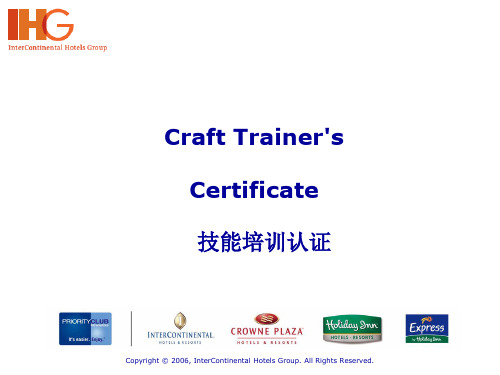
6. Succession Planning:继任计划 Setting and achieving goals to move on to the next step in their career. 设置和完成目标从而进行下一步。
5. Assessment - Training and Development:评估-培训和发展 DH’s with potential to move into GM positions, will attend assessment and development programs.有可能成为
3
Copyright © 2006, InterContinental Hotels Group. All Rights Reserved.
The Employee Lifecycle 员工的职业周期
1. Preparing The Organization组织 框架的准备: Ensuring management is competent in all aspects of bringing new staff into the hotel.确保通过管理可以很好的使新员 工融入酒店 2. Communicating Expectations To Employees: 将期望传达给员工 Send out the right messages to all new employees.向所有新员工传递正确 的信息
Copyright © 2006, InterContinental Hotels Group. All Rights Reserved.
Range范围
Program Outline培训纲要 Day 1:
Introduction导言
绩效管理制度培训英文
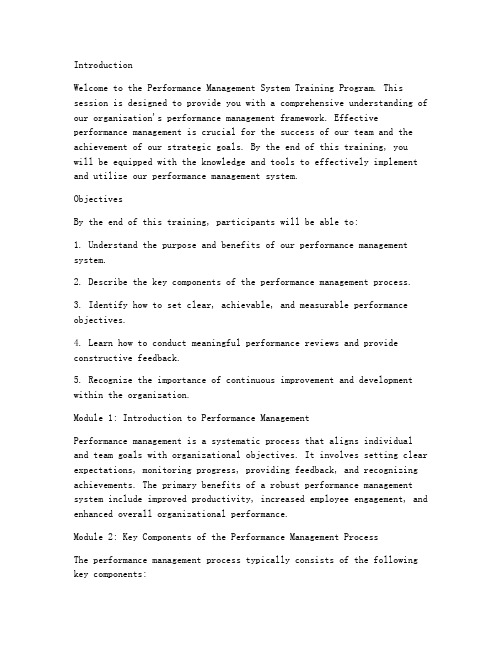
IntroductionWelcome to the Performance Management System Training Program. This session is designed to provide you with a comprehensive understanding of our organization's performance management framework. Effective performance management is crucial for the success of our team and the achievement of our strategic goals. By the end of this training, youwill be equipped with the knowledge and tools to effectively implement and utilize our performance management system.ObjectivesBy the end of this training, participants will be able to:1. Understand the purpose and benefits of our performance management system.2. Describe the key components of the performance management process.3. Identify how to set clear, achievable, and measurable performance objectives.4. Learn how to conduct meaningful performance reviews and provide constructive feedback.5. Recognize the importance of continuous improvement and development within the organization.Module 1: Introduction to Performance ManagementPerformance management is a systematic process that aligns individual and team goals with organizational objectives. It involves setting clear expectations, monitoring progress, providing feedback, and recognizing achievements. The primary benefits of a robust performance management system include improved productivity, increased employee engagement, and enhanced overall organizational performance.Module 2: Key Components of the Performance Management ProcessThe performance management process typically consists of the following key components:1. Goal Setting: Establishing clear, achievable, and measurable objectives that align with both individual and organizational goals.2. Performance Monitoring: Regularly assessing progress towards these objectives and providing ongoing feedback.3. Performance Review: Conducting formal reviews at predetermined intervals to evaluate performance, discuss achievements, and identify areas for improvement.4. Feedback and Development: Providing constructive feedback,identifying developmental needs, and creating action plans to address performance gaps.5. Recognition and Rewards: Acknowledging and rewarding high performance to motivate and retain top talent.Module 3: Setting Clear Performance ObjectivesTo set effective performance objectives, follow these steps:1. Align with Organizational Goals: Ensure that objectives are aligned with the overall strategic direction of the organization.2. Be Specific and Measurable: Use clear and quantifiable criteria to define success.3. Ensure Objectives are Achievable: Make sure objectives are realistic and attainable within the given timeframe.4. Involve the Employee: Engage employees in the goal-setting process to increase commitment and accountability.Module 4: Conducting Performance ReviewsPerformance reviews should be conducted in a structured and consistent manner. Here are some tips for effective performance reviews:1. Prepare in Advance: Gather relevant data and prepare feedback on the employee’s performance.2. Focus on Both Strengths and Weaknesses: Provide a balanced view of the employee’s performance, highlighting both achievements and areasfor improvement.3. Use a Constructive Approach: Offer feedback in a supportive and encouraging manner.4. Develop an Action Plan: Identify specific steps the employee can take to improve performance.Module 5: Continuous Improvement and DevelopmentContinuous improvement and development are essential for personal and organizational growth. Here’s how you can foster a culture of continuous improvement:1. Encourage Learning: Provide opportunities for employees to acquire new skills and knowledge.2. Offer Developmental Resources: Access to training, coaching, and mentoring programs.3. Celebrate Successes: Recognize and reward employees for their contributions and achievements.4. Create a Feedback Loop: Encourage open communication and feedback from all levels of the organization.ConclusionThe performance management system is a dynamic tool that can help drive our organization’s success. By u nderstanding and effectively implementing this system, we can ensure that our team is aligned, engaged, and focused on achieving our strategic goals. Thank you for participating in this training program, and we look forward to seeing the positive impact of our performance management system on our organization’s future.。
中欧在线全系列通用管理课程清单(2010双语)

your staff
Responding to poor performance 如何祝贺和夸奖员工
Congratulate a colleague 好的目标有什么特点
目标制定 Formulating your What is a good goal?
goals
目标明确,行动更有效
Fix your goals clearly to reach them better 年度评估面谈:烦人的任务还是建设性的机会?
让你的“推销”适应目标客户的明确需求 Adapt your „pitch‟ to your target‟s express needs
提升说服力 Boost your power of persuasion
通过实例学习如何推销大项目 Master large project selling with the help of a real-world example
处理客户异议 Dealing with your client‟s objections 向签单冲刺 Concluding a sale
加深对潜在客户的了解 Improving your understanding of your prospect‟s situation
提出需要解决的问题触动潜在客户 Motivate your target by raising problems that need resolving
-1-
成功进行职业发展面谈
成功进行员工面谈
Carry out a successful professional development meeting 处理违规员工
Successfully managing face-to-face meetings with
Coaching
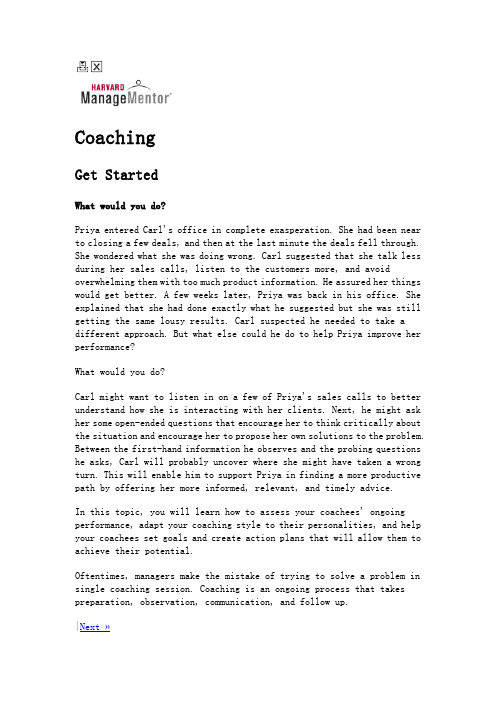
CoachingGet StartedWhat would you do?Priya entered Carl's office in complete exasperation. She had been near to closing a few deals, and then at the last minute the deals fell through. She wondered what she was doing wrong. Carl suggested that she talk less during her sales calls, listen to the customers more, and avoid overwhelming them with too much product information. He assured her things would get better. A few weeks later, Priya was back in his office. She explained that she had done exactly what he suggested but she was still getting the same lousy results. Carl suspected he needed to take a different approach. But what else could he do to help Priya improve her performance?What would you do?Carl might want to listen in on a few of Priya's sales calls to better understand how she is interacting with her clients. Next, he might ask her some open-ended questions that encourage her to think critically about the situation and encourage her to propose her own solutions to the problem. Between the first-hand information he observes and the probing questions he asks, Carl will probably uncover where she might have taken a wrong turn. This will enable him to support Priya in finding a more productive path by offering her more informed, relevant, and timely advice.In this topic, you will learn how to assess your coachees' ongoing performance, adapt your coaching style to their personalities, and help your coachees set goals and create action plans that will allow them to achieve their potential.Oftentimes, managers make the mistake of trying to solve a problem in single coaching session. Coaching is an ongoing process that takes preparation, observation, communication, and follow up.|Next »Get StartedTopic ObjectivesThis topic helps you:∙Recognize that coaching is an ongoing, two-way process that takes place as the need or opportunity arises∙Implement a four-step process to prepare for and lead effective coaching sessions∙Conduct coaching sessions using a variety of coaching techniques ∙Provide ongoing support and follow-through for the person being coached∙Strengthen your coaching skills« Previous |Next »Get StartedAbout the MentorsInteraction Associates, Inc.Interaction Associates, Inc. is a performance-improvement company offering a powerful suite of collaboration consulting and learning services. The company equips clients with practical new strategies, skills, and mindsets so they can leverage the power of collaborative action to solve problems and create opportunities. Since 1969, Interaction Associates has helped global leaders, the Fortune 100, and government agencies to overcome their most difficult challenges.Linda A. HillFrom her more than 20 years of extensive field work, Professor Linda A. Hill has helped managers create the conditions for effective management in today's flatter and increasingly diverse organizations. She is aprofessor and chair of the Leadership Initiative at Harvard Business School. She is also the author of the best-selling Becoming a Manager (Harvard Business School Press), now out in paperback. Linda served as the content expert for Coaching for Results and Managing Direct Reports, two award-winning interactive programs from Harvard Business School Publishing. She has also served as a mentor for many Harvard ManageMentor topics.« Previous |Next: Learn »Learn« Previous: Get Started|Next »Coaching OverviewWhat is coaching?Like any manager, you have a huge interest in developing your employees' capabilities. In most cases, this is accomplished through coaching. Coaching is an ongoing, two-way process in which a manager and direct report share knowledge and experience to maximize the direct report's potential and help him or her achieve agreed-upon goals. Coaching relies on collaboration and requires a positive, supportive emotional bond between coach and coachee.Many people use the words coaching and mentoring interchangeably, but the two functions differ. Coaching focuses on immediate performance problems and learning opportunities, while mentoring emphasizes long-term personal career development. Moreover, while a coach is often the supervisor of the person being coached, a mentor is seldom the boss ofthe person being mentored. Finally, a coach directs the learning and instruction during the coaching process, while the mentored person takes charge of his or her own learning during the mentoring process.« Previous |Next »Why coach?You cannot teach a man anything. You can only help him discover it within himself.—Galileo GalileiCoaching generates numerous benefits for you and your company.It's useful for:∙Overcoming costly and time-consuming performance problems∙Strengthening employees' skills so you can delegate more tasks to them and devote time to more important responsibilities—such as planning∙Boosting productivity by helping your employees work smarter ∙Creating promotable direct reports who can step into your shoes as you advance up the career ladder∙Improving retention, because employees are more loyal and motivated when their boss takes time to help them improve their skills ∙Fostering a positive work culture in the form of greater job satisfaction and higher motivation∙Making more effective use of company resources, because coaching costs less than formal training« Previous |Next »ActivityHow's your coaching?Coaching OverviewWhy coach?Activity: How's your coaching?Evaluate your current effectiveness as a coach by answering Yes or No to the following questions. As you go along, manually keep track of how many correct answers you make.Do you observe your direct reports' behavior?YesCorrect choice. You prepare to coach by observing, to identify whether and how the employee's behavior negatively affects others or interferes with the employee's ability to succeed.NoNot the best choice. You prepare to coach by observing, to identify whether and how the employee's behavior negatively affects others or interferes with the employee's ability to succeed.Do you form and test hypotheses about your direct reports' behavior before acting on them?YesCorrect choice. From your observations, form a hypothesis about the performance problem, such as skill gaps or lack of knowledge, and its effect. Then test your hypothesis, perhaps by confidentially asking another manager to observe a situation, or by asking open-ended questions.NoNot the best choice. From your observations, form a hypothesis about the performance problem, such as skill gaps or lack of knowledge, and itseffect. Then test your hypothesis, perhaps by confidentially asking another manager to observe a situation, or by asking open-ended questions.Do you use your own performance as a yardstick to measure others?YesNot the best choice. Your own performance is not an appropriate measure. Instead, evaluate the unique strengths that individuals bring to a job.NoCorrect choice. Your own performance is not an appropriate measure. Instead, evaluate the unique strengths that individuals bring to a job.Do you prepare employees for coaching sessions in advance?YesCorrect choice. Coaching is a partnership, so it's important to invite an employee to participate in the coaching process and to help them understand how the process will unfold.NoNot the best choice. Coaching is a partnership, so it's important to invite an employee to participate in the coaching process and to help them understand how the process will unfold.Do you use open-ended questions to promote sharing of ideas and information?YesCorrect choice. Open-ended questions (those that don't require merely a "yes" or "no" answer) encourage participation and generate ideas for addressing a performance problem or skills gap.NoNot the best choice. Open-ended questions (those that don't require merely a "yes" or "no" answer) encourage participation and generate ideas for addressing a performance problem or skills gap.Do you blend inquiry (asking questions) with advocacy (offering opinions and ideas) during discussions with individuals you're coaching?YesCorrect choice. While coaching, you rely extensively on inquiry—asking questions. But an over-reliance on inquiry can make coachees feel like they're being interrogated.NoNot the best choice. While coaching, you rely extensively on inquiry—asking questions. But an over-reliance on inquiry can make coachees feel like they're being interrogated.Do you decide what approach is needed to solve the employee's problem?YesNot the best choice. Rather than mandate the solution, it's best to determine collaboratively where help is needed and what type of help would best address the performance problems or skill gaps.NoCorrect choice. Rather than mandate the solution, it's best to determine collaboratively where help is needed and what type of help would best address the performance problems or skill gaps.Do you work with your direct reports to reach agreement on desired goals and outcomes?YesCorrect choice. Successful coaching requires agreement on goals.NoNot the best choice. Successful coaching requires agreement on goals.Do you give feedback that focuses on behavior and its consequences (rather than on vague judgments)?YesCorrect choice. During the coaching process, provide feedback regularly. The best feedback is specific. For example, you might say, "I liked theway you used visuals to illustrate the problem, and then invited people to comment on the timetable," rather than, "Great presentation."NoNot the best choice. During the coaching process, provide feedback regularly. The best feedback is specific. For example, you might say, "I liked the way you used visuals to illustrate the problem, and then invited people to comment on the timetable," rather than, "Great presentation."Do you follow up on coaching discussions to make sure progress is proceeding as planned?YesCorrect choice. It's important to periodically check progress and understanding with your direct report as the coaching process unfolds.NoNot the best choice. It's important to periodically check progress and understanding with your direct report as the coaching process unfolds.How many of the previous assessment questions did you answer correctly?0-3Learning the fundamentals of coaching and practicing how to apply them will help you improve your performance as a manager. Review the suggestions for improvement beside each answer.4-7Your coaching skills can be improved by learning to follow a coaching process. Review the suggestions for improvement beside each answer.8-10You likely have most of the skills required to be an effective coach, and may just need to brush up on the coaching process. Review the suggestions for improvement beside each answer.What are the skills and qualities necessary for effective coaching?Exit activityWhen should you coach?Coaching is an ongoing process, taking place as the need or opportunity arises. Often, coaching occurs informally as you discuss goals, challenges, and on-the-job performance with employees while providing helpful feedback during day-to-day encounters.At other times, the coaching process can be more focused and formal; you set up structured meetings with a coachee to establish goals and review progress.Coaching also has a direct link to performance appraisal. Often, a manager offers to provide coaching for a direct report after a performance appraisal reveals a correctable problem or the need to develop particular skills essential for advancement.« Previous |Next »See AlsoTips for when to coachWhom should you coach?Every situation in a manager's life presents opportunities for coaching.Consider these examples:∙Herb is a talented market researcher but spends more of his time at his computer than in meetings with market planners and newproduct developers. His valuable findings aren't making their way into company plans, and his career is stalled.∙Claudia is a fast learner, works well with others, and understands the company's goals. You'd like to promote her, but her reluctance to confront difficult, argumentative people is holding her back.∙Tim is a smart and hardworking employee, and you'd like to delegate more challenging tasks to him so you can devote more time to planning.But Tim needs to acquire a few more skills to perform the tasks you'd like to delegate to him.∙Shirley, whom you recently promoted to supervisor, isn't delegating enough tasks to her subordinates; she's trying to do everythingherself. Moreover, when she leads meetings with her team, themeetings end inconclusively and run overtime.All of these situations are examples of employees who either have a performance problem or skills gap—both of which are ideal targets for coaching.As an experienced manager, you have plenty of knowledge to share with each of these employees. But since you have limited time, it's best to invest it in coaching opportunities that will deliver the highest return. As illustrated in the examples above, these arise when:∙ A new subordinate needs direction∙ A direct report is almost ready for new responsibilities and needs just a bit more help∙ A problem performer can be brought up to an acceptable level of work if he or she receives some guidanceBut remember, because coaching is based on mutual agreement, it's not always the best way to handle certain performance problems. You need to intervene more directly when a staff member has clearly violated company policy or organizational values or performance remains flat despite multiple coaching sessions.« Previous |Next »Personal InsightsBe a good mentorCoaching OverviewWhom should you coach?Be a good mentorPersonal InsightI was once very privileged to have working with me a very, very bright guy who had been in strategic planning. He then came to me when I was the Chief Executive of the bank on a two-year attachment. He was very talented, but also very diffident. He would come in to my office and say: "what would you like me to do?" I'd say: "Well, this is the issue, what do you think?" And he would not have any idea at all. He'd say: "Well, I'll do whatever you want." I would say: "No, no, why don't you go away and think about it and think what should we do about this issue?" Gradually, he became more and more confident, more able to suggest ways of tackling things, and he grew in stature. You could almost physically see that he'd gota significantly more confident bearing. And that's terribly important. You must then make sure that they don't become so confident that they become arrogant, because they're working in a slightly controlled environment when you're acting as a mentor to them.So the great thing to do is to give these people roots to grow and wings to fly, and ensure that they maintain the fine balance between humility and arrogance.Nurturing talent by growing people's confidence is both rewarding and beneficial to an organization. However, a leader must ensure people don't get over-confident following this investment in their development.Peter EllwoodGroup Chairman, ICIPeter Ellwood began his career at Barclays in 1961 and rose to become Chief Executive of Barclaycard from 1985 until 1989. During this time he was also a Director of the Board of Visa European Union. He was Chairman of the Board of Visa International from 1994–1999.He joined TSB Bank as Chief Executive of Retail Banking in 1989 and became Group Chief Executive in 1992. Following the merger with Lloyds Bank in 1995, Peter Ellwood became Deputy Group CEO of Lloyds TSB.He became Deputy Chairman of Imperial Chemical Industries (ICI), one of the world's largest producers of specialty products and paints, in June 2003 and now holds the position of Chairman.He was made a Commander of the British Empire for services to banking in 2001. He is also Chairman of The Work Foundation, and Chairman of the Race Equality and Diversity Task Force of the Institute for Public Policy Research.« Previous |Next »The Coaching ProcessFour stepsEffective coaches recognize that coaching is a process that has four discrete phases.Key IdeaThe coaching process has four steps:1.Preparation: You observe a potential coachee, test your hypothesesabout his or her skills or performance, listen for signals that your help is needed, estimate the probability of improvement, and ask the employee to prepare for coaching.2.Initial discussion of skills and performance: Share yourobservations with the potential coachee, ask questions and listen actively to his or her responses, and explore potential causes of the performance problem or the need for new skills. Next, agree on goals and create an action plan that will best address performance problems or close skill gaps.3.Ongoing dialogue: Check your coachee's progress on the action plan,refine your approach, blend inquiry with advocacy, and givefeedback.4.Follow up: You regularly discuss what's working well and what isn't,and make any needed adjustments in the goals or the coachingprocess.« Previous |Next »PreparationObserve behaviorObservation is the key to accurately assessing your employee's strengths and weaknesses. Learn the best methods to observe without forming premature judgments.Key IdeaObserve your employee's behavior both informally (for example, during a meeting) and formally (such as on joint sales calls). Learn what the person is doing well and not doing well, or what skills he or she has or needs.In the case of performance problems, assess the impact of the person's behavior on others and on the employee's ability to achieve stated goals.For example, during several team meetings, you notice that Priya repeatedly interrupts others. You wonder whether her behavior prevents others from expressing their views.As you continue observing, avoid forming premature judgments about the employee's character. For example, instead of deciding that "Priya doesn't respect others," stick to the facts: "Priya interrupted three participants in the first meeting and five participants during the second meeting."Discuss your observations with trusted colleagues, in confidence. If possible, ask them to observe the person in question.For instance, invite a colleague to attend a meeting and observe Priya.« Previous |Next »See AlsoObservation worksheetTest hypothesesThe greatest compliment that was ever paid me was when one asked me what I thought, and attended to my answer.—Henry David ThoreauBased on your observations, form hypotheses (theories) about what's going on. For instance, "Priya needs to learn when to speak up and when to listen to what others have to say."But, as you form theories, ask yourself if you've done anything to cause or enable the problem behaviors you're observing. For example, consider these tendencies:∙Unrealistic expectations. Are you using your own performance as a yardstick to measure others? Assuming that others' strengths are the same as yours is unrealistic and unfair.∙Inferring feelings. Are you failing to identify with someone who's having a problem? Your anger or frustration may communicate itself to the employee and affect performance.∙Failing to listen. Have you missed signals that the person needs help? If you haven't listened carefully in the past, you may have passed up chances to help earlier.∙Failing to praise. Have you failed to compliment the employee on something he or she has done well? If so, the employee may lack the confidence or motivation to perform well.∙Failing to model desirable behaviors.Have you practiced the skills and behaviors that you expect of your employee? If not, the personmay not realize how important certain behaviors (such as listening) are.Ask the colleague afterward to describe what he or she saw. These additional observations can help confirm or refute your conclusions.« Previous |Next »ActivityHow not to coachSee AlsoTips for forming hypothesesPreparationTest hypothesesActivity: How not to coachThough Mindy has trouble closing sales, she is excellent at meeting prospective new customers. Her contact list is full of executive-level prospects with whom she has a positive working relationship. When Beverly meets with Mindy to coach her on her job performance, she tries to be as helpful as possible. She focuses on Mindy's challenges in closing sales, and says, "I realize this is hard for you. What are your thoughts about the situation?" Mindy looks upset.Which negative coaching tendency did Beverly exhibit?Beverly did not show empathy.Not the best choice.Beverly did show empathy, by saying, "I realize this is hard for you."Beverly failed to listen.Not the best choice.Beverly did demonstrate a willingness to listen, when she asked Mindy, "What are your thoughts about the situation?"Beverly failed to praise.Correct choice. Beverly failed to recognize Mindy's strengths and successes and to praise her for them. Remembering to praise is an important part of coaching.Rafael works at a well-known bank. Before he was promoted to manager, he was a top credit analyst. The bank rarely lost money on clients for which Rafael approved loans. Now, as a manager, Rafael must coach Olivia, a former peer, who is demonstrating what Rafael considers to be questionable performance as a credit analyst. During a coaching session, Rafael expresses his appreciation for the areas where Olivia has progressed in her job. Then, to reassure her, he says, "The kind of performance I'm after is possible. When I was in your position, I could always spot the high-risk loan applicants." Olivia becomes quiet for the rest of the session.Which negative coaching tendency did Rafael exhibit?Rafael had unrealistic expectations.Correct choice. Rafael expected Olivia to have the same strengths as he does (credit analysis). He therefore missed the reasons behind her difficulty with the job, which may include a need for training.Rafael failed to model desirable behaviors.Not the best choice.Rafael modeled high performance in this job area when he was a credit analyst in the same group as Olivia.Rafael failed to praise.Not the best choice. Rafael did offer praise when he expressed appreciation for the areas where Olivia has progressed in her job.Elise has been coaching her employee, Tran, to prepare him for a promotion. During a recent coaching session, Tran expresses qualms about taking on the new job. Elise says, "I understand that you're nervous. But I don't want you to think you have to deliver perfect performance the first day on the new job. There's no need to be worried about the new role."Which negative coaching tendency did Elise exhibit?Elise had unrealistic expectations.Not the best choice.When Elise said, "I don't want you to think you have to deliver perfect performance the first day on the new job," she let Tran know that she has realistic expectations.Elise failed to show empathy.Not the best choice. Elise showed empathy when she said, "I understand that you're nervous."Elise failed to listen.Correct choice. By saying "There's no need to be worried about the new role," Elise made it clear that she hadn't really listened to Tran's worries. When an employee expresses this sort of concern, the manager needs to provide coaching centered on building confidence or strengthening a particular skill.Unproductive tendencies can make it difficult to coach effectively. Can you identify negative coaching behaviors?Exit activityListen for signalsGather additional information by listening for signals indicating the kind of coaching that may be needed. The table below provides examples.Common Signals to Act OnIf your employee says . . . He or she may need help . . . "I can't finish the project on time."Managing time"Maybe Ed should do this job." Building confidence or strengtheninga particular skill"About that new job . . . I'm not really interested." Preparing to take on greater responsibilities « Previous |Next »Evaluate potential successThere is no use whatever trying to help people who do not helpthemselves. You cannot push anyone up a ladder unless he be willing to climb himself.—Andrew CarnegieBased on your observations and hypotheses, consider:∙"Is the person willing and able to be helped?" Coaching works only when the coachee willingly agrees to participate.∙ "Is the performance problem solvable?" Some problems are so deeply ingrained that no amount of coaching can help. How do you identify such problems? Unproductive behavior —whether it's bossiness, competitiveness, or lack of self-confidence —that manifests itself frequently and in a wide variety of situations most likely can't be improved through coaching. « Previous |Next »Prepare the employeeTo prepare your direct report for coaching, have the person appraise his or her work performance. Ask:∙"To what extent have you achieved your goals?"∙"Which goals, if any, have you exceeded?"∙"Are there particular goals that you're currently struggling to achieve?"∙"What is preventing you from reaching your goals? Is it lack of training, resources, or direction from me?"If the purpose of the coaching is to prepare someone for a new job or a higher level of responsibility, ask the person to compare his or her current competencies against those required by the new position or responsibility, and to identify any gaps.Implementing these forms of self-appraisal has the following benefits: ∙The employee plays an active role in the coaching experience.∙ A tone of partnership is established.∙The employee becomes more open to feedback from you.∙You gain a new perspective on the person's work and reduce the risk of misjudging the situation.« Previous |Next »See AlsoCoach’s plann ing formInitial DiscussionLink observed behaviors to impact on othersTo affect a positive change in performance, cite the impact of your coachee's behaviors on group goals and coworkers. Listen as Priya receives feedback about her tendency to interrupt others.Key IdeaWhen you meet with your employee to share what you've observed, discuss your observations of the employee's actual behaviors, instead of suppositions about his or her personal character or motives. Try to begin the coaching session with a positive observation and then focus on any constructive feedback you have to deliver.For example: "Priya, I want to compliment you on your participation in last Tuesday's meeting. You clearly did your homework, as always. There's one area where your participation could be even more effective.。
c2_what_is_mbti
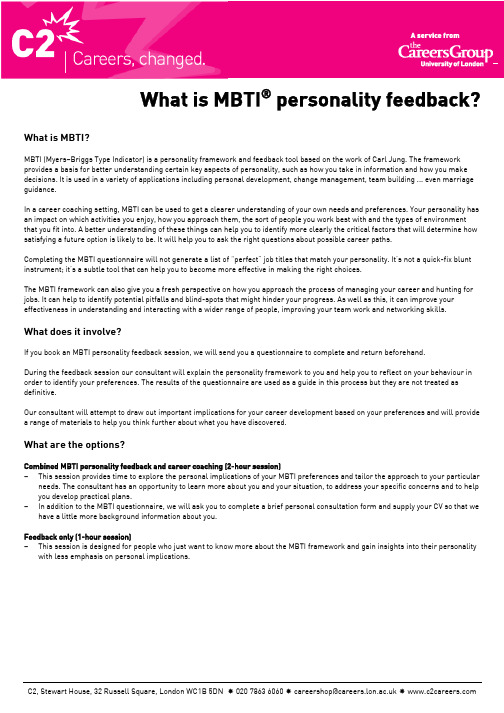
What is MBTI® personality feedback? What is MBTI?MBTI (Myers–Briggs Type Indicator) is a personality framework and feedback tool based on the work of Carl Jung. The framework provides a basis for better understanding certain key aspects of personality, such as how you take in information and how you make decisions. It is used in a variety of applications including personal development, change management, team building ... even marriage guidance.In a career coaching setting, MBTI can be used to get a clearer understanding of your own needs and preferences. Your personality has an impact on which activities you enjoy, how you approach them, the sort of people you work best with and the types of environment that you fit into. A better understanding of these things can help you to identify more clearly the critical factors that will determine how satisfying a future option is likely to be. It will help you to ask the right questions about possible career paths.Completing the MBTI questionnaire will not generate a list of “perfect” job titles that match your personality. It’s not a quick-fix blunt instrument; it’s a subtle tool that can help you to become more effective in making the right choices.The MBTI framework can also give you a fresh perspective on how you approach the process of managing your career and hunting for jobs. It can help to identify potential pitfalls and blind-spots that might hinder your progress. As well as this, it can improve your effectiveness in understanding and interacting with a wider range of people, improving your team work and networking skills.What does it involve?If you book an MBTI personality feedback session, we will send you a questionnaire to complete and return beforehand.During the feedback session our consultant will explain the personality framework to you and help you to reflect on your behaviour in order to identify your preferences. The results of the questionnaire are used as a guide in this process but they are not treated as definitive.Our consultant will attempt to draw out important implications for your career development based on your preferences and will provide a range of materials to help you think further about what you have discovered.What are the options?Combined MBTI personality feedback and career coaching (2-hour session)−This session provides time to explore the personal implications of your MBTI preferences and tailor the approach to your particular needs. The consultant has an opportunity to learn more about you and your situation, to address your specific concerns and to help you develop practical plans.−In addition to the MBTI questionnaire, we will ask you to complete a brief personal consultation form and supply your CV so that we have a little more background information about you.Feedback only (1-hour session)−This session is designed for people who just want to know more about the MBTI framework and gain insights into their personality with less emphasis on personal implications.C2, Stewart House, 32 Russell Square, London WC1B 5DN 020 7863 6060 careershop@ 。
新编文档-Generation Gap Closing the Generation Gap in the Workplace关闭在职场代沟代沟-精品文档
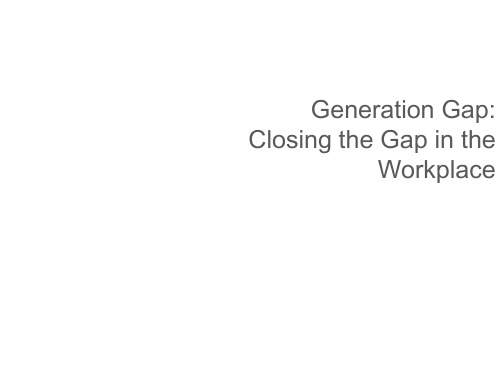
Vietnam War, and the Cold War • Technology advanced at a rapid pace • Family and associated supports such as church
laid off from work as businesses downsized, reorganized, and re-engineered • People started to look to college and university as a normal extension of school, rather than as something reserved only for the very wealthy
Session Two: History in Brief
Session Three: Finding Common Ground
• Individuals across all generations have very similar values.
• The place where conflict arises is in how the values are expressed.
• What we see are the ways that previous generations have great influence on younger generations despite also having differences, and the ongoing idea that each generation cannot possibly meet the needs of the other.
BEC中级阅读解析
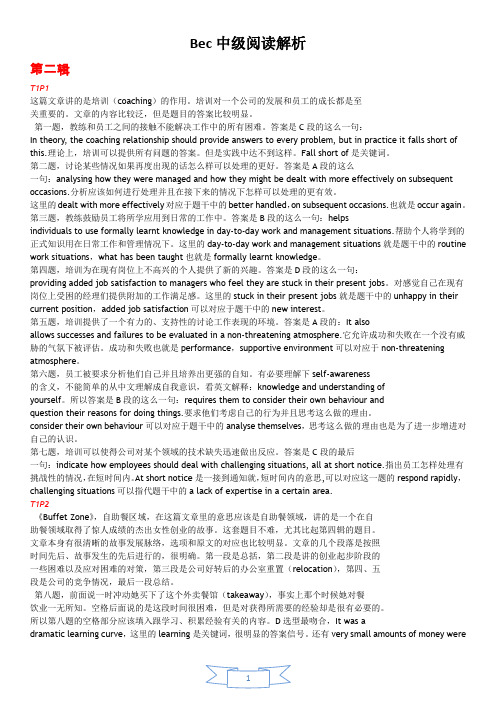
Bec中级阅读解析第二辑T1P1这篇文章讲的是培训(coaching)的作用。
培训对一个公司的发展和员工的成长都是至关重要的。
文章的内容比较泛,但是题目的答案比较明显。
第一题,教练和员工之间的接触不能解决工作中的所有困难。
答案是C段的这么一句:In theory, the coaching relationship should provide answers to every problem, but in practice it falls short of this.理论上,培训可以提供所有问题的答案。
但是实践中达不到这样。
Fall short of是关键词。
第二题,讨论某些情况如果再度出现的话怎么样可以处理的更好。
答案是A段的这么一句:analysing how they were managed and how they might be dealt with more effectively on subsequent occasions.分析应该如何进行处理并且在接下来的情况下怎样可以处理的更有效。
这里的dealt with more effectively对应于题干中的better handled,on subsequent occasions.也就是occur again。
第三题,教练鼓励员工将所学应用到日常的工作中。
答案是B段的这么一句:helpsindividuals to use formally learnt knowledge in day-to-day work and management situations.帮助个人将学到的正式知识用在日常工作和管理情况下。
这里的day-to-day work and management situations就是题干中的routine work situations,what has been taught也就是formally learnt knowledge。
英语种子教师培训研修计划
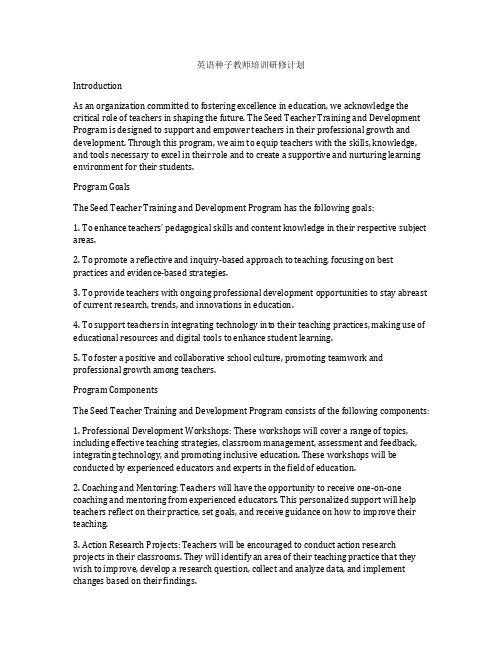
英语种子教师培训研修计划IntroductionAs an organization committed to fostering excellence in education, we acknowledge the critical role of teachers in shaping the future. The Seed Teacher Training and Development Program is designed to support and empower teachers in their professional growth and development. Through this program, we aim to equip teachers with the skills, knowledge, and tools necessary to excel in their role and to create a supportive and nurturing learning environment for their students.Program GoalsThe Seed Teacher Training and Development Program has the following goals:1. To enhance teachers’ pedagogical skills and content knowledge in their respective subject areas.2. To promote a reflective and inquiry-based approach to teaching, focusing on best practices and evidence-based strategies.3. To provide teachers with ongoing professional development opportunities to stay abreast of current research, trends, and innovations in education.4. To support teachers in integrating technology into their teaching practices, making use of educational resources and digital tools to enhance student learning.5. To foster a positive and collaborative school culture, promoting teamwork and professional growth among teachers.Program ComponentsThe Seed Teacher Training and Development Program consists of the following components:1. Professional Development Workshops: These workshops will cover a range of topics, including effective teaching strategies, classroom management, assessment and feedback, integrating technology, and promoting inclusive education. These workshops will be conducted by experienced educators and experts in the field of education.2. Coaching and Mentoring: Teachers will have the opportunity to receive one-on-one coaching and mentoring from experienced educators. This personalized support will help teachers reflect on their practice, set goals, and receive guidance on how to improve their teaching.3. Action Research Projects: Teachers will be encouraged to conduct action research projects in their classrooms. They will identify an area of their teaching practice that they wish to improve, develop a research question, collect and analyze data, and implement changes based on their findings.4. Collaborative Lesson Planning: Teachers will engage in collaborative lesson planning sessions, where they can share ideas, resources, and best practices with their colleagues. This will promote a culture of collaboration and shared learning among teachers.5. Professional Learning Communities: Teachers will be encouraged to participate in professional learning communities, where they can engage in discussions, share their experiences, and learn from one another. These communities will provide a platform for teachers to collaborate and support each other in their professional growth.Program ImplementationThe Seed Teacher Training and Development Program will be implemented over the course of the academic year. The program will commence with an orientation session for participating teachers, where they will be introduced to the program components and expectations. The program will then unfold through a series of workshops, coaching sessions, and collaborative activities, providing ongoing support and guidance to teachers.Monitoring and EvaluationThe effectiveness of the Seed Teacher Training and Development Program will be monitored and evaluated through various means, including teacher feedback, classroom observations, and assessment of student learning outcomes. This feedback will be used to make adjustments and improvements to the program, ensuring that it continues to meet the needs and expectations of participating teachers.ConclusionThe Seed Teacher Training and Development Program aims to create a culture of continuous learning and professional growth among teachers. By providing teachers with the support and resources they need to excel in their role, we believe that this program will not only benefit individual teachers, but also contribute to the overall improvement of the quality of education in our schools. We are committed to empowering teachers to be effective and inspiring educators, who can create a meaningful impact on the lives of their students.。
我如何做高绩效教练GROW模型
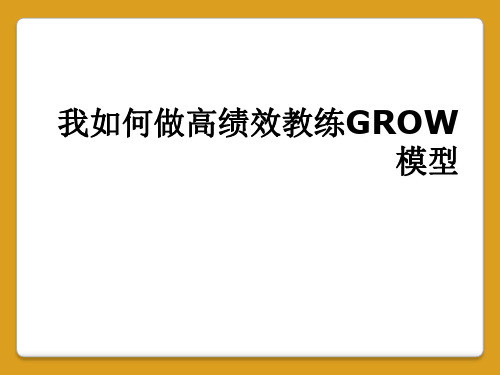
Coaching: the art of asking questions
Spontaneous Raising coachee’s awareness Open Questions
When and What can you coach
You can coach in basically every situation
The traditional concept of management:
managing = Giving Orders managing = controlling managing = solving problems yourself
Reasons for being Doer (2) Internal / Personal reasons
A response to to be leaner, flatter, faster, better etc
As standards keep rising , managing to improve performance is the key to profitability and to achieving your business goals in an increasingly competitive world
NOT
TO GET INFORMATION FOR THE QUESTIONER
BUT
TO DEVELOP THE LEARNER`S AWARENESS TO SHARPEN THE LEARNER`S FOCUS TO STIMULATE LEARNER`S RESPONSIBILITY TO HELP THE LEARNER FIND THEIR OWN ANSWERS TO GET LEARNER TO TAKE OWNERSHIP OF THE PROCESS
大学生迟到旷课早退现象英语作文
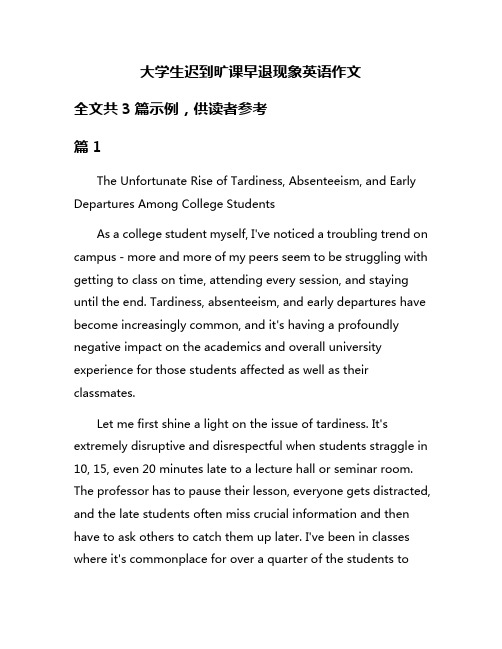
大学生迟到旷课早退现象英语作文全文共3篇示例,供读者参考篇1The Unfortunate Rise of Tardiness, Absenteeism, and Early Departures Among College StudentsAs a college student myself, I've noticed a troubling trend on campus - more and more of my peers seem to be struggling with getting to class on time, attending every session, and staying until the end. Tardiness, absenteeism, and early departures have become increasingly common, and it's having a profoundly negative impact on the academics and overall university experience for those students affected as well as their classmates.Let me first shine a light on the issue of tardiness. It's extremely disruptive and disrespectful when students straggle in 10, 15, even 20 minutes late to a lecture hall or seminar room. The professor has to pause their lesson, everyone gets distracted, and the late students often miss crucial information and then have to ask others to catch them up later. I've been in classes where it's commonplace for over a quarter of the students toshow up late on any given day. The reasons run the gamut from staying up too late the previous night, to poor time management, to seemingly treating class start times as mere suggestions. As a punctual student who makes an effort to arrive a few minutes early, it's extremely frustrating.Even more concerning is when students just don't show up to classes at all. I've had required courses where the absentee rate hovers around 50% some sessions. This inevitably leads to a slowdown for the whole class as concepts have to bere-explained for the missing students. It puts an immense burden on the professor who has to field countless requests for personal catch-up sessions and excuse notes. Class discussions suffer when half the voices are missing. Those skipping out aren't learning, but their absenteeism also directly hinders the education of their peers who did show up. The reasons for absenteeism tend to be similar to tardiness - poor time management, prioritizing other activities over academics, or simply being lazy and apathetic.The final piece of this unfortunate puzzle is students who show up for the first portion of a class only to pack up and leave halfway through or sooner. I've witnessed auditoriums full of students steadily trickle out over the last 30-40 minutes of alecture until just a quarter of them remain by the end. It's incredibly rude and an insult to the professor. Early departures tend to be more common in large lectures where it's easier to anonymously exit without being as noticeable. Students cite reasons like having to be somewhere else, losing interest and focus, and assuming they won't miss anything important by leaving the tail end of the lesson. However, numerous studies show the negative academic impacts of missing those final precious minutes where lessons are summarized, key takeaways are reiterated, and upcoming assignments are explained.So what's driving this unfortunate rise in tardiness, absenteeism, and early departures among university students? Based on my observations and conversations with others, there are a few key factors. The first is the widespread condition of being over-committed and over-scheduled. Today's students are often trying to juggle a full course load while also working one or more jobs to make ends meet and pay skyrocketing tuition fees. They may be involved in multiple extracurricular activities, volunteer roles, student clubs and organizations, research projects, internships, etc. This leaves them constantly rushed, stressed, and struggling to get everything done or be everywhere they need to be on time. Proper time management skills are lacking.Another factor is the pervasiveness of personal technologies and digital distractions. Students are constantly tempted by mobile phones, digital messaging, video games, social media, streaming services, and other tech that provides an endless deluge of distractions, procrastination wormholes, and disruptions to focus and productivity. These same technologies have also diminished attention spans and created unhealthy expectations around instant gratification.The perceived lack of value, importance, or relevance that some students place on their courses and class time is also an issue. If students don't understand how the material will be meaningful and important for their future goals, they're less inclined to prioritize it. Beliefs like "I'll never use this after I graduate" or "I can just teach myself this from online videos" can demotivate students from showing up, paying attention, and recognizing the big-picture benefits of being present.Finally, I'd be remiss not to mention the potential impacts of the Covid-19 pandemic and prevailing periods of remote/online learning. For several years, many college students grew accustomed to more flexible, self-paced virtual classes. The abrupt transition back to in-person learning and strictattendance expectations has been a stark adjustment that some students haven't yet recalibrated to successfully.At the end of the day, tardiness, absenteeism, and early departures among university students stem from a combination of factors like overscheduling, personal distractions, lack of perceived relevance, and pandemic-induced transitions. But the impacts are very real - students falling behind, missing crucial content, developing poor life habits, disrupting their peers' learning experiences, squandering their families' financial sacrifices, diminishing classroom dynamics and morale, and potentially underperforming academically. It's an issue that universities need to address proactively through better student coaching, stressing accountability, incentivizing positive behaviors, and exploring scheduling/curriculum adjustments.Speaking candidly, I'll admit to occasionally falling victim to some of these poor habits myself earlier in my college years. But I've made concerted efforts to improve my punctuality, commitment, and focus through better personal time management, limiting distractions and procrastination triggers, and maintaining a mindset of respect for my professors, peers, and education overall. I can attest to experiencing better academic performance, reduced stress, and an enriched learningexperience as a result. It's a constant process of awareness, discipline, and prioritization.In closing, the phenomenon of tardiness, absenteeism, and early departures continues to run rampant on too many college campuses. It's a systemic issue rooted in a combination of time management challenges, personal distractions and lack of focus, perceived lack of relevance/motivation, and lingering pandemic impacts to academic routines. Students themselves need to develop better habits, but universities must also explore progressive policies, creative scheduling solutions, curriculum refinements, and support resources to proactively address this troubling trend and its numerous negative ramifications. The value and quality of the higher education experience is at stake.篇2The Pervasive Issue of College Students Being Tardy, Skipping, and Leaving Class EarlyAs a college student, I've noticed a concerning trend on campus – an increasing number of my peers arriving late to class, skipping lectures altogether, or leaving well before the class is dismissed. This phenomenon, while not new, seems to be escalating and becoming more widespread. As someone whovalues education and strives for academic success, I find this behavior perplexing and detrimental to the learning process.First and foremost, let's address the issue of tardiness. I understand that occasionally, unforeseen circumstances can arise, causing a student to be late for class. However, what I've observed goes beyond the occasional late arrival. Some students consistently stroll into the lecture hall 10, 15, or even 20 minutes after the class has begun, disrupting the flow of the lesson and distracting their classmates. Not only is this disrespectful to the professor, but it also hinders the late student's ability to fully comprehend the material being taught.Moving on to the more egregious offense of skipping classes entirely. While I recognize that college life can be demanding, with various commitments vying for our attention, intentionally missing lectures should not be treated as an acceptable practice. Each class session is carefully designed to impart valuable knowledge and facilitate a deeper understanding of the subject matter. By choosing to skip class, students deprive themselves of the opportunity to engage with the material, ask questions, and participate in discussions that could enhance their learning experience.Furthermore, the act of leaving class early is another concerning behavior that merits attention. I've witnessed students packing up their belongings and exiting the classroom well before the scheduled end time, sometimes as much as 20 or 30 minutes early. This practice not only demonstrates a lack of respect for the professor and the educational process but also deprives the student of potentially crucial information or insights that may be shared in the latter part of the class.The reasons behind these behaviors are multifaceted and complex. Some students may struggle with time management or prioritization, failing to recognize the importance of regular class attendance. Others may be burdened by personal or family obligations that conflict with their academic schedules. Additionally, the prevalence of online resources and recorded lectures can create a false sense of security, leading some students to believe that they can easily catch up on missed material on their own time.However, it is crucial to understand that attending classes in person offers invaluable benefits that cannot be replicated through independent study or online resources alone. The classroom environment fosters dynamic discussions, immediatefeedback, and opportunities for collaborative learning that can significantly enhance the educational experience.Moreover, the habits formed during college years often shape future professional conduct. By embracing tardiness, absenteeism, and early departures, students risk developing patterns that could hinder their success in the workplace. Employers value punctuality, commitment, and respect for colleagues and superiors – traits that are cultivated through consistent and responsible class attendance.To address this issue, a multi-pronged approach is necessary. First and foremost, raising awareness among students about the detrimental impact of these behaviors is crucial. Educational institutions should prioritize emphasizing the value of regular class attendance and punctuality, highlighting the long-term consequences of developing poor habits.Additionally, professors can play a vital role in promoting engagement and accountability. By implementing policies that discourage tardiness and absenteeism, such as deducting participation points or implementing stricter attendance requirements, professors can incentivize students to prioritize class attendance.Furthermore, universities could explore the implementation of early intervention programs to identify and support students who are struggling with attendance issues. These programs could offer academic counseling, time management workshops, or mentorship opportunities to help students develop effective strategies for balancing their responsibilities.Lastly, fostering a campus culture that celebrates academic excellence and values the pursuit of knowledge is essential. By encouraging peer-to-peer accountability, promoting study groups, and recognizing students who consistently demonstrate dedication and punctuality, universities can create an environment that celebrates and reinforces positive academic behaviors.In conclusion, the phenomenon of college students arriving late, skipping classes, and leaving early is a multifaceted issue that demands attention and proactive measures. While the reasons behind these behaviors may vary, the consequences are far-reaching, impacting not only the individual student's academic success but also the overall learning environment and the integrity of the educational process. By raising awareness, implementing supportive policies, and cultivating a culture of academic excellence, we can work towards mitigating thisconcerning trend and ensuring that students receive the full benefits of their college education.篇3The Troubling Trend of Tardiness, Truancy, and Early ExitsAs a university student, one of the most frustrating issuesI've encountered is the widespread problem of my peers being consistently late to class, skipping lectures entirely, or leaving before they've even finished. This cavalier attitude towards attendance and punctuality is not only disruptive and disrespectful to professors and other students, but it's also detrimental to the overall learning experience and academic success of those who engage in such behavior.Let's start with tardiness. While the occasional late arrival due to unforeseen circumstances is understandable, there are some students who simply cannot seem to make it to class on time, even when there are no legitimate excuses. They'll stroll in 10, 15, even 20 minutes late, not only missing crucial information from the lecture, but also creating a disturbance as they awkwardly find a seat. The inconsiderate nature of this habit is hard to overstate—it shows a blatant disregard for theprofessor's time and efforts, as well as a lack of respect for their classmates whose learning is interrupted.Even more problematic is the chronic absenteeism that plagues many courses. There are always a handful of students who perpetually skip class, whether it's due to laziness, a lack of interest in the subject matter, or misguided priorities. What these individuals fail to grasp is that regular attendance and active participation are vital components of the university experience. Material taught in lectures is often pivotal for exams, assignments, and reinforcing key concepts. By willfully missing out on this first-hand instruction, truant students are essentially shooting themselves in the foot academically.But perhaps the most perplexing and irksome tendency is the phenomenon of students leaving class early—well before the scheduled end time. I've witnessed countless instances of this, with students abruptly packing up their belongings and scurrying out the door anywhere from 10 to 30 minutes prematurely. Not only is this supremely impolite and distracting, but it also deprives those students of potentially crucial information, insights, or Q&A sessions that often occur towards the end of a lecture.So why do these problematic behaviors persist at the university level, where one would assume a certain degree of maturity and dedication to learning? There are likely multiple factors at play, none of which are particularly compelling excuses.For some, it may simply be a lingering sense of apathy or lack of self-discipline that carried over from high school days. The sudden autonomy and lack of stern oversight that comes with university life can be a difficult adjustment, leading some students to take their educational responsibilities too lightly.Others may be trying to juggle excessive course loads, part-time jobs, or other commitments, leaving them perpetually rushed, flustered, and unable to manage their time effectively. While these external pressures are understandable, they don't justify compromising one's academic integrity and performance.Then there are those who simply don't see the value in attending certain lectures, either because they find the delivery style boring or they overestimate their ability to successfully self-study the material. This misguided mindset overlooks the fact that even a supposedly "dry" lecture can offer valuable insights, opportunities for clarification, and a more structured, guided approach to learning.Ultimately, chronic tardiness, truancy, and premature exits from class are not only self-sabotaging behaviors, but they're also disruptive, inconsiderate, and detrimental to the overall academic environment. For those of us who take our education seriously and wish to get the most out of our costly tuition dollars, these trends are nothing short of infuriating.As students, we owe it to ourselves, our professors, and our fellow classmates to approach our studies with dedication, respect, and a genuine commitment to personal growth and intellectual development. That means making attendance a top priority, being punctual out of courtesy, and remaining fully engaged until lectures have officially concluded.Admittedly, there will always be exceptional circumstances that force us to occasionally miss a class or step out early. But when tardiness, truancy, and early exits become the norm rather than the exception, it's a clear indicator that there are deeper issues at play—whether it's poor time management, lack of motivation, or a failure to recognize the value of sustained commitment.I sincerely hope that more of my peers will start to appreciate the immense privilege we have in being able to pursue higher education, and that they'll begin to actaccordingly. Because at the end of the day, our collective dedication and respect for the learning process doesn't just benefit us individually—it enriches the entire academic community and preserves the integrity of the university experience for all.。
英语培训计划表模板
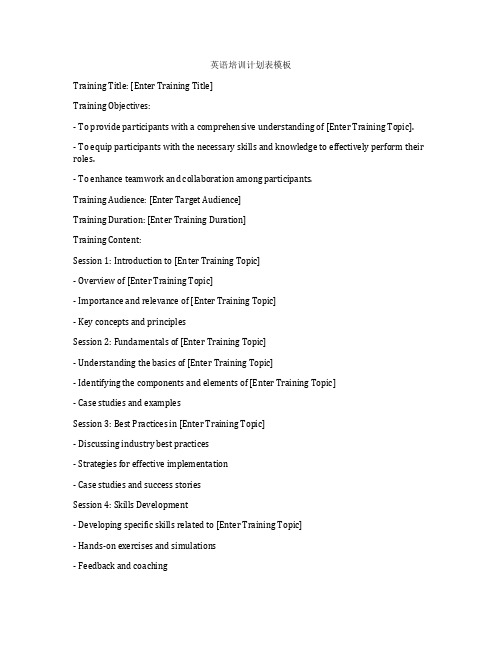
英语培训计划表模板Training Title: [Enter Training Title]Training Objectives:- To provide participants with a comprehensive understanding of [Enter Training Topic]. - To equip participants with the necessary skills and knowledge to effectively perform their roles.- To enhance teamwork and collaboration among participants.Training Audience: [Enter Target Audience]Training Duration: [Enter Training Duration]Training Content:Session 1: Introduction to [Enter Training Topic]- Overview of [Enter Training Topic]- Importance and relevance of [Enter Training Topic]- Key concepts and principlesSession 2: Fundamentals of [Enter Training Topic]- Understanding the basics of [Enter Training Topic]- Identifying the components and elements of [Enter Training Topic]- Case studies and examplesSession 3: Best Practices in [Enter Training Topic]- Discussing industry best practices- Strategies for effective implementation- Case studies and success storiesSession 4: Skills Development- Developing specific skills related to [Enter Training Topic]- Hands-on exercises and simulations- Feedback and coachingSession 5: Teamwork and Collaboration- Importance of teamwork in relation to [Enter Training Topic]- Collaboration techniques and tools- Group activities and discussionsSession 6: Challenges and Solutions- Identifying common challenges related to [Enter Training Topic] - Strategies for overcoming challenges- Case studies and real-world examplesSession 7: Performance Evaluation- Assessing the impact of the training on participants' performance - Feedback and improvement plans- Next steps and follow-up actionsTraining Methods:- Instructor-led presentations- Group discussions and activities- Case studies and examples- Hands-on exercises and simulations- Peer-to-peer learning- Feedback and coachingTraining Materials:- Presentation slides- Handouts and worksheets- Case studies and examples- Exercises and simulations- Evaluation formsTraining Evaluation:- Pre-training assessment to determine participants' knowledge and skills- Post-training evaluation to measure the impact of the training- Feedback and improvement plans- Follow-up actions and supportTraining Schedule:Day 1:- Session 1: Introduction to [Enter Training Topic]- Session 2: Fundamentals of [Enter Training Topic]Day 2:- Session 3: Best Practices in [Enter Training Topic]- Session 4: Skills DevelopmentDay 3:- Session 5: Teamwork and Collaboration- Session 6: Challenges and SolutionsDay 4:- Session 7: Performance Evaluation- Post-training evaluation and feedbackNote: The above schedule is a sample and can be customized based on the training duration and specific requirements.Training Facilitators:- [Enter Facilitator Name]- [Enter Facilitator Name]Training Resources:- Training venue- Audio-visual equipment- Training materialsTraining Budget:- Itemized budget for venue, equipment, materials, facilitator fees, etc.Training Follow-up:- Follow-up actions and support- Ongoing feedback and improvement plans- Opportunities for further developmentTraining Plan Approval:- [Enter Approver's Name and Title]- [Enter Approver's Signature]- [Enter Date]Note: This is a generic training plan template and should be customized to fit the specific needs and requirements of each training program.。
篮球俱乐部英语作文
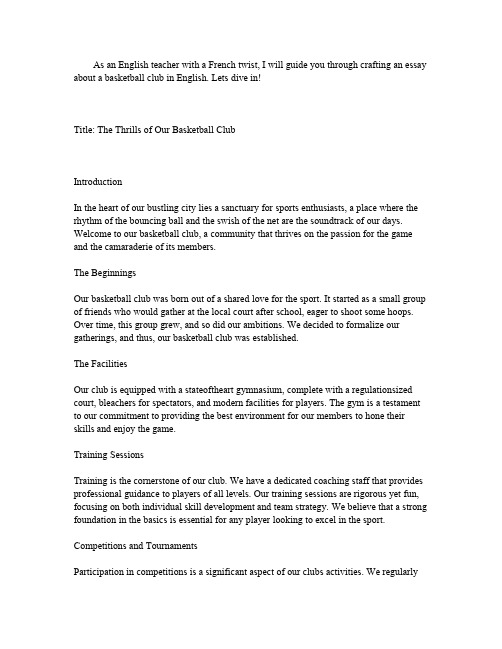
As an English teacher with a French twist,I will guide you through crafting an essay about a basketball club in English.Lets dive in!Title:The Thrills of Our Basketball ClubIntroductionIn the heart of our bustling city lies a sanctuary for sports enthusiasts,a place where the rhythm of the bouncing ball and the swish of the net are the soundtrack of our days. Welcome to our basketball club,a community that thrives on the passion for the game and the camaraderie of its members.The BeginningsOur basketball club was born out of a shared love for the sport.It started as a small group of friends who would gather at the local court after school,eager to shoot some hoops. Over time,this group grew,and so did our ambitions.We decided to formalize our gatherings,and thus,our basketball club was established.The FacilitiesOur club is equipped with a stateoftheart gymnasium,complete with a regulationsized court,bleachers for spectators,and modern facilities for players.The gym is a testament to our commitment to providing the best environment for our members to hone their skills and enjoy the game.Training SessionsTraining is the cornerstone of our club.We have a dedicated coaching staff that provides professional guidance to players of all levels.Our training sessions are rigorous yet fun, focusing on both individual skill development and team strategy.We believe that a strong foundation in the basics is essential for any player looking to excel in the sport. Competitions and TournamentsParticipation in competitions is a significant aspect of our clubs activities.We regularlyorganize and participate in local,regional,and national tournaments.These events not only provide an opportunity for our players to test their skills against other teams but also serve as a platform for networking and learning from other basketball enthusiasts.Community OutreachOur club is not just about playing basketball its about giving back to the community.We run outreach programs that introduce the sport to underprivileged children,teaching them not only the game but also the values of teamwork,discipline,and perseverance.We believe that sports have the power to change lives,and we are committed to making a difference.Social EventsOff the court,our club is a hub of social activity.We organize regular social events such as barbecues,movie nights,and holiday parties.These events are a great way for members to relax,socialize,and strengthen the bonds that make our club more than just a place to play basketball.ConclusionOur basketball club is a testament to the power of sports to bring people together.Its a place where friendships are forged,skills are honed,and dreams are chased.Whether youre a seasoned player or a newcomer to the sport,our club offers a welcoming environment where everyone can grow and enjoy the game they love.Remember,the key to a compelling essay is to engage your reader with vivid descriptions, a clear structure,and a personal touch that reflects your passion for the subject.Bonne chance with your writing!。
Coaching has become a buzz word, although it is often misunderstood
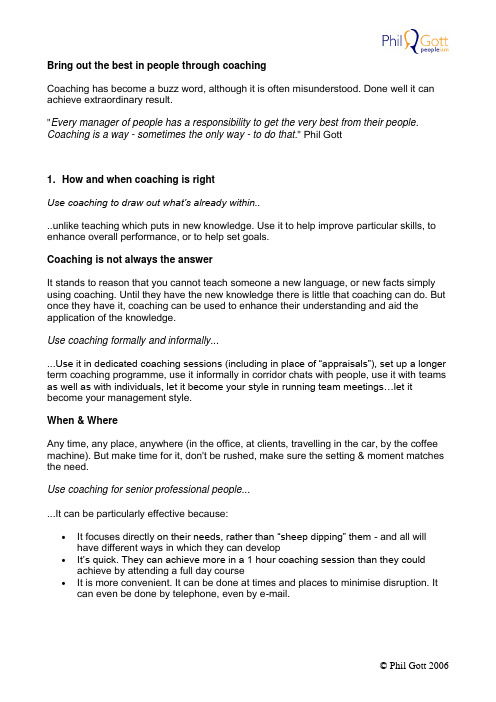
Bring out the best in people through coachingCoaching has become a buzz word, although it is often misunderstood. Done well it can achieve extraordinary result."Every manager of people has a responsibility to get the very best from their people. Coaching is a way - sometimes the only way - to do that." Phil Gott1. How and when coaching is rightUse coaching to draw out what’s already within....unlike teaching which puts in new knowledge. Use it to help improve particular skills, to enhance overall performance, or to help set goals.Coaching is not always the answerIt stands to reason that you cannot teach someone a new language, or new facts simply using coaching. Until they have the new knowledge there is little that coaching can do. But once they have it, coaching can be used to enhance their understanding and aid the application of the knowledge.Use coaching formally and informally...e it in dedicated coaching sessions (including in place of “appraisals”), set up a longer term coaching programme, use it informally in corridor chats with people, use it with teams as well as with individuals, let it become your style in running team meetings…let it become your management style.When & WhereAny time, any place, anywhere (in the office, at clients, travelling in the car, by the coffee machine). But make time for it, don't be rushed, make sure the setting & moment matches the need.Use coaching for senior professional people......It can be particularly effective because:∙It focuses directl y on their needs, rather than “sheep dipping” them - and all will have different ways in which they can develop∙It’s quick. They can achieve more in a 1 hour coaching session than they could achieve by attending a full day course∙It is more convenient. It can be done at times and places to minimise disruption. It can even be done by telephone, even by e-mail.2. The coaching relationshipRecognise potential barriers......Hierarchy may be a barrier to effective coaching; Culture may be another.Ask yourself:∙Will they really be totally open with you?∙Will they openly admit to weaknesses?∙Will they be truly honest about their career aspirations?∙If culture or hierarchy run counter to effective coaching, get someone else to do the coaching. Someone from outside the hierarchy, or outside the organisation.Coach for their benefit......Coach only for the benefit of the person being coached. Ulterior motives would damage the essential relationship of trust. Show genuine interest in them and what they want to achieve. Be approachable & accessible.Offer a choice of coach......Let them to choose their own coach; helping to gain their commitment to coaching and giving them ownership of it.Don't tell......Constrain your own knowledge of the subject on which you are coaching.You need to be an expert at coaching, not at the subject being coached. Your own knowledge of the subject can hamper coaching because it makes it frustratingly easy to start “telling”, which is not what coaching is about.Learning from sports coachesSo often, the performance of top athletes and sports people far surpasses the performance of their coaches. Mike Sprecklen, the coach to the outstanding British rowing pair Holmes and Redgrave, said “I was stuck, I had taught them all I knew tech nically, but [coaching] opens up the possibility of going further, for they can feel things I can’t even see.”When you are an expert...Knowledge of the subject being coached can help a coach in two ways:∙it can help you know what questions to ask∙and paradoxically can help to gain trust (which is very important)But just resist that temptation to slip into telling.Promise total confidentiality......And live by your promise. For someone to open up to you they need to know the information will go no further.3. How to coachGet them to take responsibility......for their own situation, solution and development.Avoid the temptation to "tell" them what you think. Your role is to help them to see things for themselves. Every time you tell them, you take responsibility away from them.Ask questions......Ask questions to help them become more self-aware. Questions are the main tool of a great coach. The questions are more important than the answers.Use a range of different types of question...Open questions..Open questions are useful for starting a discussion without leading or narrowing the ground too much. They usually begin with “how?”, “what?”, “who?”. Or “tell me about....”Reflective questions..Reflective questions are useful to elicit more information if the other person is reluctant to provide it. You simply restate a word or phrase used by the other person.For example:Other person: “There are some other problems too”You: “Other problems?”Comparative questions..Comparative questions are useful for focusing and getting more specific information. You ask the person to compare two alternatives. For example:“What do you see as the differences between the two approaches?”Specific questionsSpecific questions are useful to control and confirm a discussion. They usually begin with: “do you?”, “would you?”, “have you?”, “could you?”, “are you?”.Benchmark questionsBenchmark questions are useful to reveal just how important something is. For example: “How significant is that to you?” or “How important is that, on a scale of 1 to 10?”Questions to avoid..Avoid questions which∙start with “why…?” They can cause a defensive reaction.∙are multiple or overly complex. They usually lead to misunderstanding or focusing only on a part of the question∙are leading. You may not draw out what they really thinkListen attentively......Listen very attentively to what they are saying. Watch for non-verbal signals. Show that you are listening by:∙showing genuine interest∙not interrupting∙not making judgements∙making eye contact∙head nodding∙open posture∙facial expressionsAllow silences......Your questions should be designed to get them to see things differently, to think for themselves. Silences will also encourage them to elaborate.Watch your (body) language......Take care with your non-verbal signals. Adopt a non-judgemental tone of voice, facial expressions, etc. Keep open body posture.Ask before giving advice......Get their permission before giving feedback or making suggestions, with phrases such as “do you mind if I make a suggestion?” or “would it help if I gave you some ideas?”.Make sure they don’t give your ideas any more weight than their own.Ask before taking notes......If you want to take notes as you are coaching, ask permission first.You can use phrases such as “do you mind if I take a few notes as reminders for myself?”or “I’m going to jot down a reminder of any points I think we may want to come back to, if that’s OK?”4. Structuring a coaching sessionAdopt a structure...∙G oals∙R eality checking∙O ptions∙W ill.Then check that the action will add up to achievement of the goal. If not you will need to help lower the goal or raise the action.GoalsGoals can be longer term and/or for the coaching programme or session itself.Goals can be End goals including things like “becoming a market leader”, “to win a particular new client”, etc. Whilst important they can be less helpful for coaching because they are outside the total control of the person being coached. Get them to set Performance goals which are much more controllable and which, if achieved, are likely to give rise to the end goal being achieved. Examples of performance goals are: “to producex number of items”, "to generate x new leads and convert y% of them into new client s”, etc. Help to make the goals SMART:∙S pecific∙M easurable∙A chievable∙R elevant∙T imescaled.Reality checkingAsk how their defined goals compare with the reality now. Get them to be specific, using descriptive rather than judgemental terminology.OptionsEncourage them to creatively identify several different options to move from where theyare now to where they want to be.WillGet them to commit to what they will do, specifically, by when. Offer support, further coaching, etc.Use their agenda......Follow their line of thinking within this framework.If they get too far off track, gently suggest coming back to a point mentioned earlier. Assess their self motivation......If they are de-motivated, work on that first. Build their confidence.Aim for some small and/or quick successes.Ask them to sum up....from time to time and at the end of a coaching session.Remind them of other points that they raised earlier if you think they have missed anything (but avoid "telling").5. Coaching catalystsIntroduce feedback from other people......Feeding back of the perceptions of other people can be a helpful catalyst for change, so long as it is welcomed by the person being coached.Perception surveys and 360 degree appraisals can be particularly helpful but also need to be used with care.Perception surveysPhil Gott says: “I often use perception surveys as a catalyst for development. It’s important that people choose those from whom they would welcome feedback, so that they respect the views that come forward. I then use the feedback to help the person being coached to focus on areas they would like to improve. That’s not to say that those giving feedback are always right, but they are always their perceptions and often that’s what matters.”360 degree appraisals..People ism runs a 360 degree appraisal process for several clients. Tailored questionnaires are sent to people nominated by an individual. From the replies, a confidential report is prepared.This is a powerful catalyst for a coaching-style appraisal meeting carried out either by a line manager or by People ism.Use video for skills coaching...e video to help them see things from a different perspective. Again, video helps to heighten self-awareness.As a coach you can help by asking coaching questions: “what do you notice from what you see?”, “how does it feel to you when that is happening?”6. When you are being coachedCommit yourself......to the coaching exercise, which is for your benefit. Be as open and honest as you can. Let your coach heighten your self-awareness......through questioning. Don't look to your coach for answers. The answers are within you. Take as much time as you need to think about questions and don't feel rushed. Answer openly, honestly and comprehensively.Say whatever thoughts come to mind......Don't worry about getting off track. Your coach will bring you back if necessary.。
员工辅导记录表范文
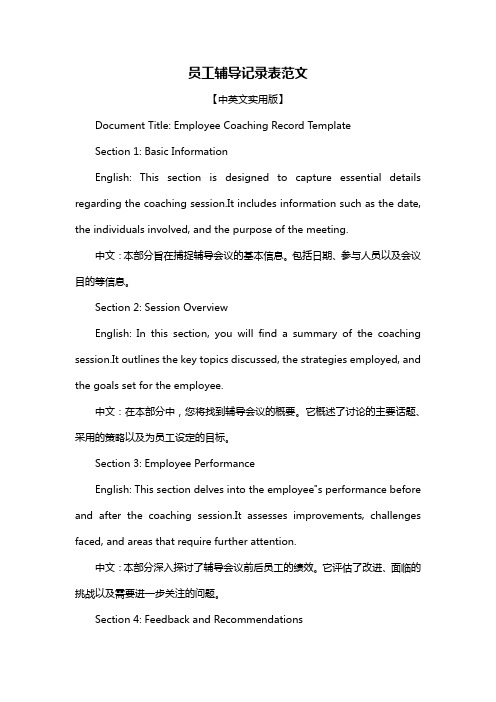
员工辅导记录表范文【中英文实用版】Document Title: Employee Coaching Record TemplateSection 1: Basic InformationEnglish: This section is designed to capture essential details regarding the coaching session.It includes information such as the date, the individuals involved, and the purpose of the meeting.中文:本部分旨在捕捉辅导会议的基本信息。
包括日期、参与人员以及会议目的等信息。
Section 2: Session OverviewEnglish: In this section, you will find a summary of the coaching session.It outlines the key topics discussed, the strategies employed, and the goals set for the employee.中文:在本部分中,您将找到辅导会议的概要。
它概述了讨论的主要话题、采用的策略以及为员工设定的目标。
Section 3: Employee PerformanceEnglish: This section delves into the employee"s performance before and after the coaching session.It assesses improvements, challenges faced, and areas that require further attention.中文:本部分深入探讨了辅导会议前后员工的绩效。
Mercer美世经典-人才管理2汇编
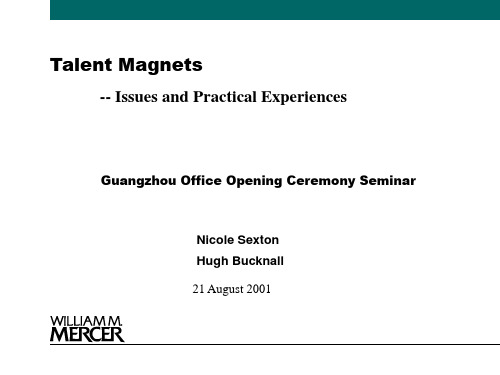
How are others responding to the challenge
Diagnostics Tools Case studies
William M. Mercer, Incorporated
14
Managing talent in a systematic way
Talent Profile
Wm M Mercer Private Survey in Singapore 2000
William M. Mercer, Incorporated
7
William M. Mercer, Incorporated
8
High-performance talent management creates an employee-customer-profit chain
Unemployment rates
Market share Employment cost
Competition (location and number) Labor pool
William M. Mercer, Incorporated
Organizational practices
Employment risk Managerial turnover Bonus participation Supervision Workload Pay levels and structure
Responding to the challenge
Diagnostics Tools Case studies
Take aways
How do you rate Tools you can use
William M. Mercer, Incorporated
拳击运动员训练作文英语
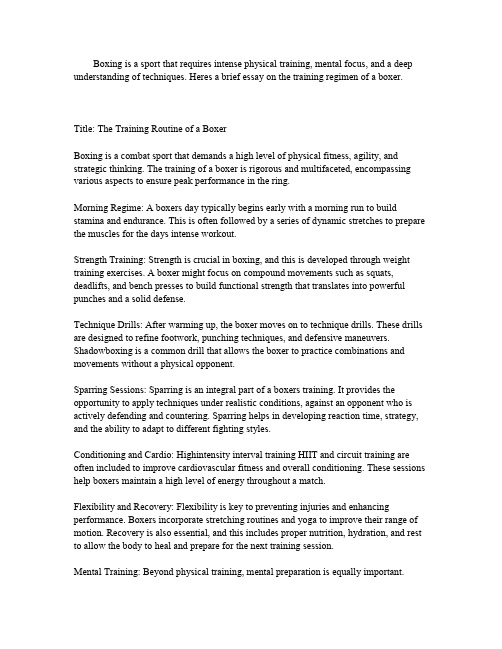
Boxing is a sport that requires intense physical training, mental focus, and a deep understanding of techniques. Heres a brief essay on the training regimen of a boxer. Title: The Training Routine of a BoxerBoxing is a combat sport that demands a high level of physical fitness, agility, and strategic thinking. The training of a boxer is rigorous and multifaceted, encompassing various aspects to ensure peak performance in the ring.Morning Regime: A boxers day typically begins early with a morning run to build stamina and endurance. This is often followed by a series of dynamic stretches to prepare the muscles for the days intense workout.Strength Training: Strength is crucial in boxing, and this is developed through weight training exercises. A boxer might focus on compound movements such as squats, deadlifts, and bench presses to build functional strength that translates into powerful punches and a solid defense.Technique Drills: After warming up, the boxer moves on to technique drills. These drills are designed to refine footwork, punching techniques, and defensive maneuvers. Shadowboxing is a common drill that allows the boxer to practice combinations and movements without a physical opponent.Sparring Sessions: Sparring is an integral part of a boxers training. It provides the opportunity to apply techniques under realistic conditions, against an opponent who is actively defending and countering. Sparring helps in developing reaction time, strategy, and the ability to adapt to different fighting styles.Conditioning and Cardio: Highintensity interval training HIIT and circuit training are often included to improve cardiovascular fitness and overall conditioning. These sessions help boxers maintain a high level of energy throughout a match.Flexibility and Recovery: Flexibility is key to preventing injuries and enhancing performance. Boxers incorporate stretching routines and yoga to improve their range of motion. Recovery is also essential, and this includes proper nutrition, hydration, and rest to allow the body to heal and prepare for the next training session.Mental Training: Beyond physical training, mental preparation is equally important.Boxers often engage in visualization techniques, where they mentally rehearse fights and strategies. This helps in building confidence and reducing anxiety before a match.Coaching and Feedback: A coach plays a vital role in a boxers training. They provide guidance, feedback, and adjustments to techniques, ensuring that the boxer is constantly improving and refining their skills.Nutrition: A balanced diet is fundamental to a boxers performance. Nutrition plans are tailored to meet the energy demands of training and to support muscle recovery and growth.In conclusion, the training of a boxer is a comprehensive program that combines physical conditioning, technical skill development, mental preparation, and strategic planning. It is a testament to the dedication and discipline required to excel in the sport of boxing.。
乒乓球俱乐部缺点英语作文
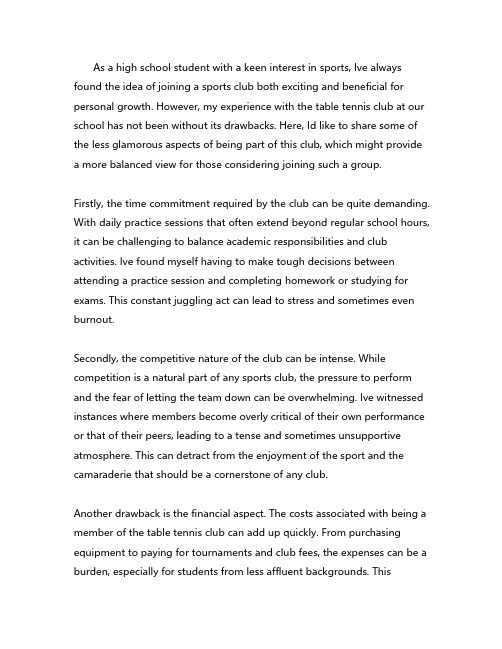
As a high school student with a keen interest in sports, Ive always found the idea of joining a sports club both exciting and beneficial for personal growth. However, my experience with the table tennis club at our school has not been without its drawbacks. Here, Id like to share some of the less glamorous aspects of being part of this club, which might provide a more balanced view for those considering joining such a group.Firstly, the time commitment required by the club can be quite demanding. With daily practice sessions that often extend beyond regular school hours, it can be challenging to balance academic responsibilities and club activities. Ive found myself having to make tough decisions between attending a practice session and completing homework or studying for exams. This constant juggling act can lead to stress and sometimes even burnout.Secondly, the competitive nature of the club can be intense. While competition is a natural part of any sports club, the pressure to perform and the fear of letting the team down can be overwhelming. Ive witnessed instances where members become overly critical of their own performance or that of their peers, leading to a tense and sometimes unsupportive atmosphere. This can detract from the enjoyment of the sport and the camaraderie that should be a cornerstone of any club.Another drawback is the financial aspect. The costs associated with being a member of the table tennis club can add up quickly. From purchasing equipment to paying for tournaments and club fees, the expenses can be a burden, especially for students from less affluent backgrounds. Thisfinancial strain can sometimes overshadow the love for the sport itself.Moreover, the physical demands of the sport can take a toll on ones body. Long hours of practice and the repetitive nature of table tennis can lead to injuries, such as wrist strains or back problems. Ive personally experienced some discomfort and had to take breaks from the club to recover, which can disrupt the continuity of training and affect performance.Additionally, the clubs facilities and resources can sometimes be inadequate. With a limited number of tables and equipment, members often have to wait for their turn to practice, which can be frustrating and inefficient. The lack of proper maintenance of the equipment can also be a concern, as it can affect the quality of training and increase the risk of injury.Lastly, the clubs management and coaching can sometimes be inconsistent. Ive noticed that the coaching staffs availability and the quality of their instruction can vary, which can impact the learning experience and the overall development of the members. This inconsistency can be disheartening, especially for those who are eager to improve their skills and excel in the sport.In conclusion, while joining a table tennis club can offer numerous benefits such as improving physical fitness, learning teamwork, and enhancing strategic thinking, it is important to be aware of the potential drawbacks. The time commitment, competitive pressure, financial demands, physical strain, inadequate facilities, and inconsistent coaching are all aspects thatone should consider before committing to such a club. It is crucial to weigh these factors against the benefits to make an informed decision about whether joining a sports club is the right choice for you.。
教练技术流程和话术
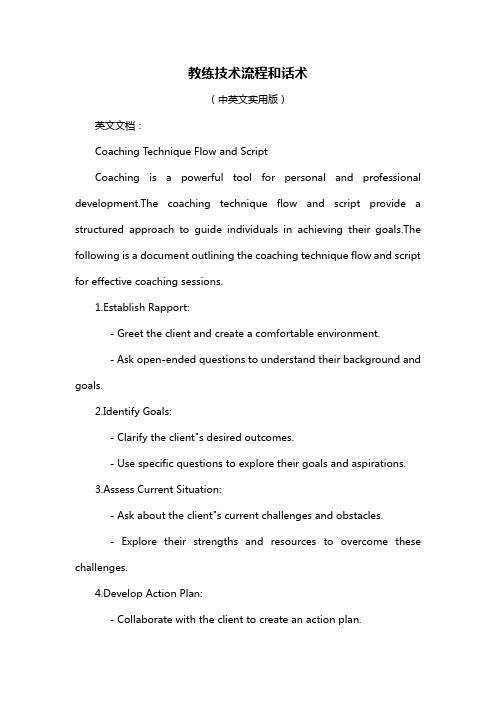
教练技术流程和话术(中英文实用版)英文文档:Coaching Technique Flow and ScriptCoaching is a powerful tool for personal and professional development.The coaching technique flow and script provide a structured approach to guide individuals in achieving their goals.The following is a document outlining the coaching technique flow and script for effective coaching sessions.1.Establish Rapport:- Greet the client and create a comfortable environment.- Ask open-ended questions to understand their background and goals.2.Identify Goals:- Clarify the client"s desired outcomes.- Use specific questions to explore their goals and aspirations.3.Assess Current Situation:- Ask about the client"s current challenges and obstacles.- Explore their strengths and resources to overcome these challenges.4.Develop Action Plan:- Collaborate with the client to create an action plan.- Break down the goals into smaller, achievable tasks.5.Implement Strategies:- Discuss potential strategies and solutions.- Encourage the client to take consistent action towards their goals.6.Monitor Progress:- Schedule regular check-ins to track progress.- Provide support and accountability to the client.7.Adjust and Reflect:- Evaluate the effectiveness of the action plan.- Make necessary adjustments and reflect on the learning process.8.Celebrate Success:- Acknowledge the client"s achievements and milestones.- Encourage them to celebrate their progress and growth.9.Closing:- Summarize the key takeaways from the coaching session.- Thank the client for their participation and offer ongoing support.Remember, the coaching technique flow and script should be adaptable to the individual needs of each client.Tailoring the coaching approach will ensure a more effective and personalized coaching experience.中文文档:教练技术流程和脚本教练是一种强大的个人和专业发展工具。
- 1、下载文档前请自行甄别文档内容的完整性,平台不提供额外的编辑、内容补充、找答案等附加服务。
- 2、"仅部分预览"的文档,不可在线预览部分如存在完整性等问题,可反馈申请退款(可完整预览的文档不适用该条件!)。
- 3、如文档侵犯您的权益,请联系客服反馈,我们会尽快为您处理(人工客服工作时间:9:00-18:30)。
DEVELOPMENT OF COACHING COMPETENCIES IN STUDENTS THROUGH A PROJECT-BASED COOPERATIVE LEARNING APPROACHHans J. Witt 1, Joan R. Alabart 2, Francesc Giralt 2, Joan Herrero 2, Magda Medir 2 and Azael Fabregat 21The Dow Chemical Company, Employee Development Center, Midland, MI 48674 USA, hjwitt@ 2Universitat Rovira i Virgili, Dep. d’Enginyeria Química, Av. dels Països Catalans 26, Campus Sescelades, 43007 Tarragona SPAIN, jalabart@etseq.urv.es Abstract – First-year chemical engineering students carry out a horizontally integrated design project working in teams. The teams are each led by two fourth-year students, one taking on the role of team leader and the other of knowledge manager so that the project is also vertically integrated. Team leaders facilitate project and team management while knowledge managers facilitate the learning process of first-year students in such a way that both are essentially coaches. Fourth-year students experience alternatively both roles during the two semesters (15 weeks) of the academic year. These new roles require a new set of technical and social skills: Team management, facilitative leadership, and project management skills, which are formally introduced in the fourth-year Project Management course and put into practice in the Project Management in Practice course. The real challenge of the whole approach is ensuring that fourth-year students resist the temptation of reproducing the supervisory role of professors in the classical classroom environment, despite the pressure of achieving project objectives, the inexperience of first-year students who are not used to this approach, and the cultural inertia of the professors involved. Index terms – Coaching skills, cooperative learning, project-based learning. I NTRODUCTION Historically, engineering education has mainly focused on delivering scientific and technical information to students. However, in modern corporate environments, scientific and technical knowledge can only be applied effectively if it is combined with adequate social skills and management methodologies such as team and facilitative leadership skills and project management [1]. Social skills cannot be easily addressed after graduation by additional training [2]. They are best developed across a curriculum from the introductory to the professional levels in a stepwise fashion, with appropriate repetition and positive reinforcement. In this respect, industry has repeatedly and clearly demanded that the scope of undergraduate engineering education should be accordingly broadened [3]. The message is clear, start working the above skills as soon as possible. Project-based learning [4] coupled with cooperative learning [5] enable engineering students to combine the building of knowledge with its application to real-life problems while simultaneously developing the social skills needed in any challenging relational environment. In addition, one of the key elements for the success of any team endeavor is leadership. The challenge at hand is how to provide strong leadership to project teams formed by first-year students. The allocation of several professors to tutor each team is not practical given the constraints of limited faculty and budget. One alternative is to create and develop empowered student teams, ultimately capable of self-management; project teams formed by first-year students and led by senior undergraduate students who have fully experienced project-based and cooperative learning in their own education, and are equipped with team and facilitative leadership skills and project management know-how. This paper describes how fourth-year chemical engineering students at the School of Chemical Engineering (ETSEQ) of the University Rovira i Virgili (Tarragona, Spain), develop and practice facilitative leadership skills and apply project management methods and tools through a learning approach that combines both project-based and cooperative learning. T HE P ROJECT -B ASED C OOPERATIVE L EARNING A PPROACH (PBCLA)The PBCLA has been designed to facilitate theempowerment of teams formed by four or five first-yearstudents and two fourth-year students to carry out a design project. The first pilot experience of the PBCLA at the ETSEQ was conducted during the Spring semester of the 1996-97 academic year. Then, 3 first-year and 2 fourth-year courses, 5 instructors and 23 teams of 5-6 students were involved. Currently, when the stationary state has been reached, all first-year courses, that is 12, 2 fourth-year courses, 24 instructors and 23 teams of 4-5 students areinvolved. Over 200 senior students have gone through the PBCLA experience during this period. The reason why to devise and implement the PBCLA, the description of the approach and its assessment during the first years of implementation are described in detail elsewhere [6]-[7]. In the last two years, the assessment of the PBCLA has been extended to include measurements of the development of skills by students. This is part of a doctorate project being carried out by one of the authors with the support of DowChemical Co. It is also worth to mention that in 2001, the ETSEQ was honored by the Catalan Government with theJaume Vicens Vives accolade for the improvement in teaching achieved through the PBCLA.Figure 1 illustrates the organizational environment in which the PBCLA is implemented and takes place. The design project starts the first week of classes and lasts for the two semesters of the academic year. Thus, first-year students begin team activities when they do not possess either the necessary technical abilities and knowledge or the appropriate team-based relational skills to carry out the project.The scope of the design project has to be defined by each project team. On the one hand, the instructors (first and fourth year professors) that participate in the PBCLA select a chemical product or a process that will be the subject of study of the design project. For instance, sulfuric acid is the current 2001/02 subject while the thermal treatment of industrial wastes was selected for the 1998/99 academic year. On the other hand, each first-year instructor selects a set of instructional objectives from his/her course syllabus, which will not be covered in the regular class hours but rather achieved through the design project. The general instructional objective fixed by the school for the first-year students is that they begin the development of lifelong-learning skills within the team-based working environment of a professional chemical engineer.FIGURE 1T HE P ROJECT-B ASED C OOPERATIVE L EARNING A PPROACH AS D EPLOYED AT THE F IRST AND F OURTH A CADEMIC Y EARS OF THE C HEMICALE NGINEERING C URRICULUM AT THE ETSEQ.Project teams are encouraged and guided to attain full empowerment to make decisions in all of the tasks that constitute the learning process [4]. This level of empowerment to project teams can only be granted by first-year instructors in view of the solid leadership that fourth-year students can provide. These students have accredited the knowledge needed to carry out the project activities and have already gone through the same experience a few years ago. In addition, they have been specifically trained in facilitative leadership skills and those needed to enhance team performance [8]. However, they are now asked not to do the project activities again, that is, play the game, but rather to coach a group of first-year students through the different tasks involved in the learning process to achieve the project objectives. This new role requires that fourth-year students be equipped with facilitative leadership skills and project management know-how. This is the purpose of the Project Management (PM) course allocated in the fourth-year of the curriculum (see Figure 1).Regarding time resources for the PBCLA, each first-year instructor dedicates between 20-50% of his/her class hours to the project so that the teams can attain their goals within the school schedule. This percentage is also the weight of the project in the first-year students’ final grade in each course.The Project Management in Practice (PMP) course provides the time needed for (i) formal team meetings (3 hours per week) wherein all team members, first and fourth-year students, are present, and (ii) plenary sessions (1 hour per week) between fourth-year students and the instructors of PMP and PM. The remaining time provided by the first-year instructors, which is not dedicated to formal team meetings, is used by first-year students to carry out project activities. Instructors are present in their class hours during these activities but they are no longer responsible for any of the tasks of the learning process. They act, like fourth-year students, as coaches of the project teams.F OURTH-YEAR STUDENTS AS COACHESFourth-year students take on the roles of team leaders and knowledge m anagers in the project teams. Team leaders help first-year students develop team skills and practice project management methods and tools. Knowledge managers do the same with problem-solving and life-long learning skills. However, neither the team leader nor the knowledge manager works with first-year students on the learning activities that the project involves.The specific responsibilities of teams leaders are:• Develop and apply a method to establish the composition of project teams.• Help the team to set its overall goal and specific objectives and develop an appropriate project plan. • Manage the change that the PBCLA represents for first-year students.• Help team members to clarify their roles, responsibilities, quality standards for their jobs, team norms and operational procedures.• Manage the project and the formal team meetings.• Facilitate the development of the team through the phases of formation, solidification and optimum team performance.• Help the team to manage conflict.• Develop communication and d ecision-making skills in team members.• Facilitate the integration of new students into the team. • Evaluate regularly and provide a final grade on the development of team skills and the quality of the job done by first-year students.The responsibilities of the knowledge managers are: • Establish a liaison with first-year instructors to clearly identify their needs and requirements on the project and to assure that the project scope is aligned with them. • Identify first-year students’ knowledge gaps.• Devise learning activities to help first-year students to achieve by themselves the instructional objectives selected by the instructors.• Assure that first-year students achieve the instructional objectives.• Assist the team to connect with project stakeholders (other project teams, instructors, professionals from industry, School’s authorities, etc.) to obtain the materials and knowledge necessary to solve the project, to cooperate, to arrange for training, to obtain resources, etc.• Evaluate regularly and provide a f i nal grade on the knowledge acquisition by first-year students.Additionally, both roles share the following responsibilities:• Help the team in the application of the evaluation procedure developed by first and fourth-year students and approved by the instructors participating in the project.• Work with the professors of the PM and PMP courses to assure that the development process of the team is aligned to the School’s objectives and values.It should be noted that the roles of team leader and knowledge m anager were both assumed by only one fourth-year student during the first years of application of the PBCLA [7]. The separation of roles resulted when an assessment of the approach revealed that the workload of fourth-year students was excessive. Currently, each fourth-year student alternatively assumes these roles during each semester.The mission of the PM course is to provide the knowledge, methods, and tools on facilitative leadership and project management to fourth-year students so that they can perform effectively their coaching roles. Table I summarizes the syllabus of the PM course, which is imparted two hours per week during the whole academic year.TABLE IS YLLABUS OF THE P ROJECT M ANAGEMENT C OURSE The project-based and cooperative learning approaches.- The coach role.- Change management.- Project management.- The Team Charter.- Meeting management.- Fostering participation.- Effective decision-making.- How to provide and receive effective feedback.- Conflict management.- Facilitation tools.F OURTH-YEAR STU DENTS IN ACTIONThe learning wheel shown in Figure 2 summarizes graphically the actions involved in the PBCLA. First-year students go through the four phases of the wheel - planning, executing, reviewing and acting - as many times as it is necessary to achieve the instructional objectives and project goals stated by first-year instructors and team leaders. Fourth-year students facilitate this cyclical journey while practicing the facilitative leadership skills and project management methods and tools learned during the training activities in team-skills provided by external resources [8], under the partnership with the Dow Chemical Co., and by the PM and PMP courses. Teams go to phase 5 when the project has to be closed out at the end of each semester. The role of fourth-year students is described next for every phase of the learning wheel in Figure 2.FIGURE 2T HE L EARNING W HEEL AS E MBEDDED IN THE PBCLA.1. P LANNINGDuring the planning phase, the team leader and the knowledge manager form and focus the team. This is achieved by following a prescribed set of steps leading to the production of a team charter [9], similar to the one included in Table II. First and fourth-year students work jointly to elaborate each of the sections of the team charter. The contribution of fourth-year students focuses more on the identification of Specific, Measurable, Attainable, Relevant and Time-limited (SMART) objectives (section 6 of the team charter), and on the corresponding learning activities to fulfill those objectives (section 7). Fourth-year students1. Planning-Team Charter development-Change management-Evaluation process design2. Executing-Learning activitiesdesign3. Reviewing-Meeting management-Learning assessment4. Acting-Reflection on the learningprocess-Continuous evaluationFACILITATIVELEADERSHIP&PROJECTMANAGEMENT5. Closing out-Results communication-Reflection on the wholeexperience-Positive reinforcement-Final evaluationadopt a directive leadership style (at least during the first semester) in these two items of the charter while a problem solving style is applied in the rest of the charter items.The formulation of SMART objectives aligned to the project’s overall goal requires a combined effort of analysis and synthesis. Figure 3 is part of a tree diagram (section 8 of the team charter) that could represent the scope of the design project for any team. The first level o f deployment of the tree is generally formed by between 5-7 objectives. These objectives are selected because they pose real design problems for the sulfuric acid process (analysis) and their resolution requires the achievement of instructional objectives from different courses in a series of integrated activities (synthesis). In the example provided, instructional objectives from calculus, algebra and physics are applied to design a tank to store the raw material sulfur.TABLE IIC ONTENT OF THE T EAM C HART ER2. Rules of the team3. Meeting logistics4. Team member knowledge and skills profile5. Team’s overall goal, customers, stakeholders, and products6. SMART objectives7. Action plan8. Tree diagram9. Gantt diagram10. Stakeholder communication strategies11. Team contractFourth-year students are fully aware from their own experience that the planning phase has to be capitalized on to manage the big change that the PBCLA represents for most of the first-year students; they have been thrust into a project team which will be l ed by two fourth-year students acting only as coaches and all this within a student-centered environment where instructors will also serve as coaches, offering guidance and encouragement to teams. This sudden increase in responsibility generally creates stress in both fourth-year and first-year students. Fourth-year students are reminded that the PBCLA involves the following issues:- Greater independence from instructors and consequently greater student accountability for their learning process. - Greater initiative from students.- Taking on unfamiliar tasks and roles and, consequently, higher risks.Completion of section 5 of the team charter in Table II requires that the teams discuss thoroughly the rationale of the PBCLA. Debating about the needs of instructors, who are the clients of the project, and the needs of industry as a key stakeholder help first-year students to reflect on the very human “what’s in it for me” and buy-in to the PBCLA. In general, the development of the whole team charter provides the structure that a new team needs to start working and helps to create a comfortable climate that reduces the anxiety feelings that inevitably arise in students.FIGURE 3T REE D IAGRAM S HOWING P ART OF THE S COPE OF A P ROJECT.The last basic task of the planning phase is that fourth-year students develop the evaluation process that will be applied to themselves and to first-year students in the PBCLA. Regarding fourth-year students, the grade obtained by applying the evaluation process is directly that of the PMP course and is used to determine the grade of the PM course. The evaluation process is the only decision that needs to be approved by all of the instructors participating in the project. Basically, the evaluation process has to be a 360 degree one, including self and peer evaluation.2. E XECUTINGDuring the execution phase of the project, the knowledge manager, with the support of the team leader, designs in more or less detail the learning activities identified in section 7 of the team charter. These activities help fourth-year students to set-up clear directions and to clarify what is expected from first-year students. Knowledge managers and team leaders should do the activities before handing them out to first-year students. Thus, they can modulate the amount of work required in each activity by providing more or fewer data depending on the time available.The knowledge manager and the team leader assign activities to first-year students by taking into account their knowledge and skill profiles (section 4 of the team charter) and the project progress (Gantt diagram). Generally each knowledge manager and team leader pair applies different approaches for assigning the activities. Some assign each activity to a pair of first-year students, one of them regarded as more “capable” than the other. Others assign each activity to a responsible member that must deliver the solved activity when it is due. In this case, the whole team has to define strategies to assure personal accountability of each team member for the work done by a single student. In any event, first-year students must carry out any activity outside the time allocated to formal team meetings, either at home or during the time shared by the different project courses.3. R EVIEWING AND4. A CTINGThe reviewing and acting phases of the learning wheel in Figure 2 take place at the formal team meetings. These are carefully planned and managed by the team leader. The main purpose of these meetings is to assess learning by first-year students and to ensure that all of them achieve all of the instructional objectives in time. This is a key responsibility of the knowledge manager. The presence of passengers in the project teams is not the problem since they are easily spotted. The challenge rather lies in the fact that when first-year students self-organize to carry out the learning activities they may specialize solely in the particular skill or set of skills (making calculations, building graphs, etc.) that they excel at or like them most, which generally coincide.The approach followed by most knowledge managers to ensure that all first-year students master the instructional objectives is to ask some of them to facilitate learning to the rest of team members while knowledge managers help in the process by asking questions in greater depth. This questioning process enables knowledge managers to easily assess the degree of learning of each team member. Feedback from team leaders and knowledge managers highlights the fact that at the beginning of the project most first-year students panic when asked to present orally any material or to teach others even though they may actually master the topic. The development of both abilities is also a benefit of the PBCLA.Team leaders and knowledge managers assess whether the objectives of any activity have been accomplished during the reviewing phase. An activity is considered as accomplished when the written resolution is correct, it has been drawn up according to the final report guidelines and all of the first-year students have achieved the instructional objectives involved. Once the activity is completed, the whole team reflects on how they have interacted to carry it out. This reflection is facilitated by both the team leader and the knowledge manager by using questionnaires that address different aspects related to the learning process, such as the design of the learning activity, the role of fourth-year students, the degree of participation of team members, etc.The team proceeds again to the planning phase after the reviewing and acting phases are completed irrespectively of the evaluation of the activity; the team leader has to check the Gantt diagram to detect and analyze any time deviations from the plan, compute the actual number of hours invested in the learning activity, etc. Depending on the progress made on the project and the evaluation of the activity, the team leader has to decide whether or not to introduce changes into the plan, launch the next project activity/ies or continue working on the current activity if it has not yet been completed. In this case, the team will be spinning around the learning wheel until the activity is finalized. Depending on the complexity of the activity, the team can go around the wheel between 4-20 times. When all the activities of the project have been accomplished, the team moves to the closing-out of the project.5. C LOSING OUTA closing-out phase is systematically managed by one team of fourth-year students at the end of each semester. The purpose of this phase goes beyond merely delivering a final report to first-year instructors. Its purpose is multifold:1. Communicate the results achieved in the project.2. Evaluate the performance of team members.3. Reflect on how the team has accomplished the results:lessons learned and areas of improvement.4. Provide positive reinforcement to students.All project teams must deliver a final report and present and defend their results in a public poster session. During the five-hour long poster sessions, first-year students are interviewed individually by first-year instructors to assess the degree to which each student has achieved the instructional objectives. Thus, first-year instructors can grade individual team members and contrast their grades with those granted by team managers. The grade given by first-year instructors accounts for 30% of the project’s grade while the remaining 70% is the responsibility of fourth-year students. In the event that the first-year-student grades given by instructors differ by more than 2 points from those given by fourth-year students, a joint meeting is called upon to solve the discrepancy. This poster session compels fourth-year students to put in place mechanisms to assure that the instructional objectives are really achieved by all first-year students and to be honest in their evaluations.Poster sessions are an excellent opportunity to provide positive reinforcement to students and keep momentum. The experience shows that most first-year students can manage successfully the questioning by i n structors and, in some cases, much to the surprise of fourth-year students. When first-year students have to explain (verbalize) what they have done and, more importantly, how it was done, they gain a deeper understanding of the material and lots of positive reinforcement is generated. In addition to this, the final poster session that is held at the end of the second semester is split into two consecutive mornings. The second one is open to everybody from university, industry, and society in general (parents, spouses, friends, etc.). These stakeholders also discuss with students the results of their projects and how they have organized themselves to obtain those results. Finally, fourth-year students deliver symbolic, tangible objects with the ETSEQ logo printed on them to everybody attending the poster session to extend the lifespan of the experience by creating memories.All project teams have also to report the results accomplished in the project and how these have been achieved during each semester. This closing-out written document reports the performance of team members in the project, evaluates all feedback received from instructors andstakeholders (including the grades obtained), captures alllessons learned and makes recommendations to the instructors of the PMP course for improvements of the PBCLA. After the action involved in the other four phases of the learning wheel, it is essential to force this reflection in teams. This is particularly important at the end of the first semester since teams can identify and develop ideas of improvement and apply them during the second semester.In addition to the closing-out report, the team leader and knowledge manager deliver an oral presentation of the report to the instructors of the PMP course. The session, which is open to other fourth-year students and faculty, is an opportunity for the instructors to discuss the self and peer evaluation of fourth-year students, give feedback on technical and process related aspects of the project, assess their oral and communication skills, and provide recognition and positive reinforcement to them. This recognition is essential to call for the extra effort required from fourth-year students for making the PBCLA a success.C HANGE M ANAGEMENT I S K EYOne of the most critical items in the implementation of the PBCLA is the role of first-year instructors. As explained earlier, the instructors of the PM and PMP courses coach fourth-year students and these, in turn, do the same with first-year students. However, the latter rely strongly on their instructors at the beginning of the academic year. First-year students are very sensitive to the words, body language and actions of their instructors. It is thus important that they refrain from conveying any premature evaluation or perception on the PBCLA or its implementation since it may weaken the trustworthiness of first-year students in fourth-year students, making the task of the latter even more challenging.At the heart of the PBCLA is the concept of the empowerment of students. Students should assume responsibility for their own learning, create their own job profiles and gain the appropriate self-discipline and self-criticism to complete a complex task. In this environment, instructors can no longer assume a command-and-control role. Like fourth-year students, professors should take on a coach role. Figure 4 summarizes the fundamental role changes that instructors must assume in the PBCLA.The understanding and assumption by instructors of their role change, together with the concomitant training, are essential for the success of the PBCLA. The ETSEQ has organized external non-compulsory training in team skills, cooperative learning and other effective teaching methods since 1996. In addition, the ETSEQ has intensified its partnership with the Dow Chemical Company to obtain expertise in coaching and change management skills, particularly in faculty management education. These are essential to involve faculty in effective teaching and to deploy the PBCLA across the engineering curriculum [6].FIGURE 4C HANGES IN THE R OLE OF I NSTRUCTORS IN THE PBCLAA CKNOWLEDGMENTTo the University Rovira i Virgili for its continuous support to innovate in undergraduate education. To Dow Chemical Co., in particular to Mr. Lluís Ve rnis, for their sharing of coaching and change management expertise. Finally, to the Cahners TRACOM Group for their permission to use the Enhancing Team Performance materials.R EFERENCES[1] German Federal Ministry of Education and Research, “NewApproaches to the Education and Qualification of Engineers: Challenges and Solutions from a Transatlantic Perspective,” June 1999.[2] Industrial Research and Development Advisory Committee of theEuropean Commission (IRDAC), “Quality and Relevance, the Challenge to European Education, Unlocking Europe’s Human Potential,” 1994.[3] Buonopane, R., A., “Engineering Education for the 21st Century,Listen to Industry!,” Chemical Engineering Education, Vol. 31, No 3, 1997, pp. 166-167.[4] Woods, D., R.; Felder, R., M.; Rugarcia, A.; Stice, J., E., “The Futureof Engineering Education. Part 3. Developing Critical Skills,”Chemical Engineering Education, Spring 2000, pp. 108-117. [5] Felder, R., M.; Woods, D., R.; Stice, J., E.; Rugarcia, A., “The Futureof Engineering Education. Part 2. Teaching Methods that Work,”Chemical Engineering Education, Winter 2000, pp. 26-39. [6] Giralt, F.; Herrero, J.; Medir, M.; Grau, F., X.; Alabart, J., R., “How toInvolve Faculty in Effective Teaching,” Chemical Engineering Education, Summer 1999, pp. 244-249.[7] Giralt, F.; Herrero, J.; Grau, F., X.; Alabart, J., R.; Medir, M., “TwoWay Integration of Engineering Education Through a Design Project,”Journal of Engineering Education, April 2000, pp. 219-229.[8] The Cahners TRACOM Group, “Enhancing Team Performance.”[9] Bens, I., “Team Launch! Strategies for New Team Start-Ups,”GOAL/QPC, 2001.。
